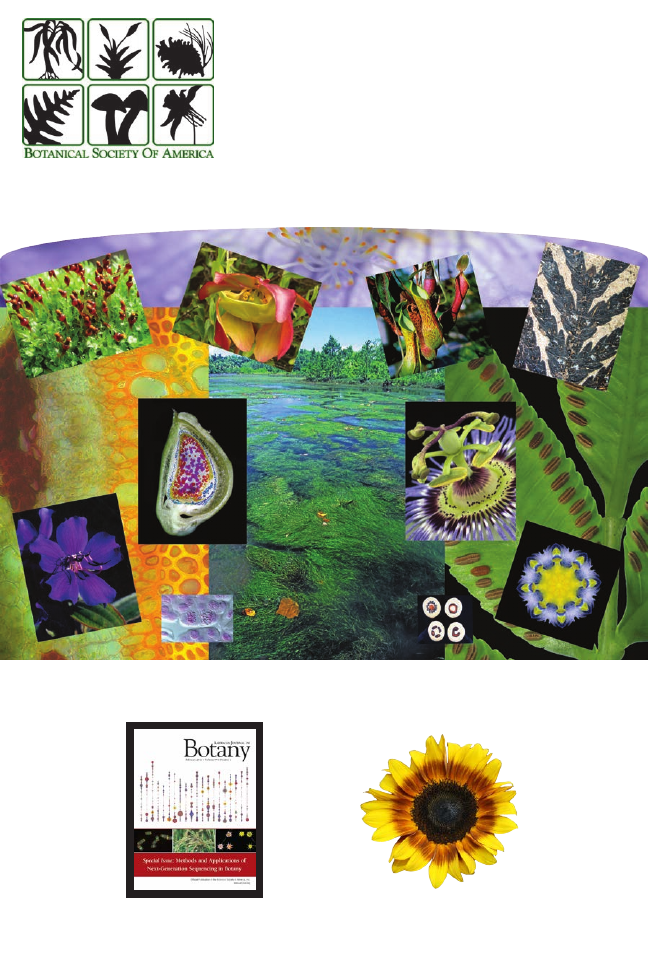
P
LANT
S
CIENCE
Bulletin
spring 2012 Volume 58 Number 1
In This Issue..............
News from the American Journal of
Botany...pp. 19, 34
Now is the time for all to submit
abstracts and register for Botany
2012. Info on back cover
The BSA
Announces
new online
resource
portal
PLANT ED!

Here it is, the spring issue of Volume 58 and
many of us are wondering what happened to
winter? We don’t have an answer for that, but
in this issue we are able to feature a holdover
from the winter issue that we were not able to
run—Dr. Raven’s plenary address from the 2011
Annual Meeting in St. Louis. During the first half
of his address, Raven reviews for us the central
role of human population in driving virtually all
of the environmental problems we face. While
for botanists this is not new information, Peter
provides us with an organized presentation
that many of us can easily integrate into an
introductory course.
The ideas I found most intriguing, however, are
in the second half of the address. Has botany as
a discipline been dying for the past half century?
Raven strongly argues that it has not, despite
the organizational changes that have occurred
in most universities. Certainly there are caveats,
and we do have to focus more on organismal
botany, but on the whole the positives outweigh
the negatives. He entreats us “to get over it, enjoy
what is being discovered, and incorporate the
new findings in our teaching and our thinking.”
Even more important, to my point of view, is that
we cannot be content to teach only our students.
The Botanical Society of America is making
nationally recognized strides in improving
scientific literacy of students of all ages, but as
Raven suggests, each of us as individual botanists
should strive to bring the message to society at
large. I hope you enjoy Peter’s address, along
with the rest of the
issue, and let’s start
thinking about how
we as individuals,
and a Society, can
have a greater
positive influence
on the scientific
thinking and actions
of society as a whole.
From the Editor
Spring 2012 Volume 58 Number1
PLANT SCIENCE
BULLETIN
Editorial Committee
Volume 58
Root Gorelick
(2012)
Department of Biology &
School of Mathematics &
Statistics
Carleton University
Ottawa, Ontario
Canada, K1H 5N1
Root_Gorelick@carleton.ca
Elizabeth Schussler
(2013)
Department of Ecology &
Evolutionary Biology
University of Tennessee
Knoxville, TN 37996-1610
eschussl@utk.edu
Christopher Martine
(2014)
Department of Biology
State University of New York
at Plattsburgh
Plattsburgh, NY 12901-2681
martinct@plattsburgh.edu
Carolyn M. Wetzel
(2015)
Department of Biological Sci-
ences & Biochemistry Program
Smith College
Northampton, MA 01063
Tel. 413/585-3687
-Marsh
Lindsey K. Tuominen
(2016)
Warnell School of Forestry &
Natural Resources
The University of Georgia
Athens, GA 30605
lktuomin@uga.edu
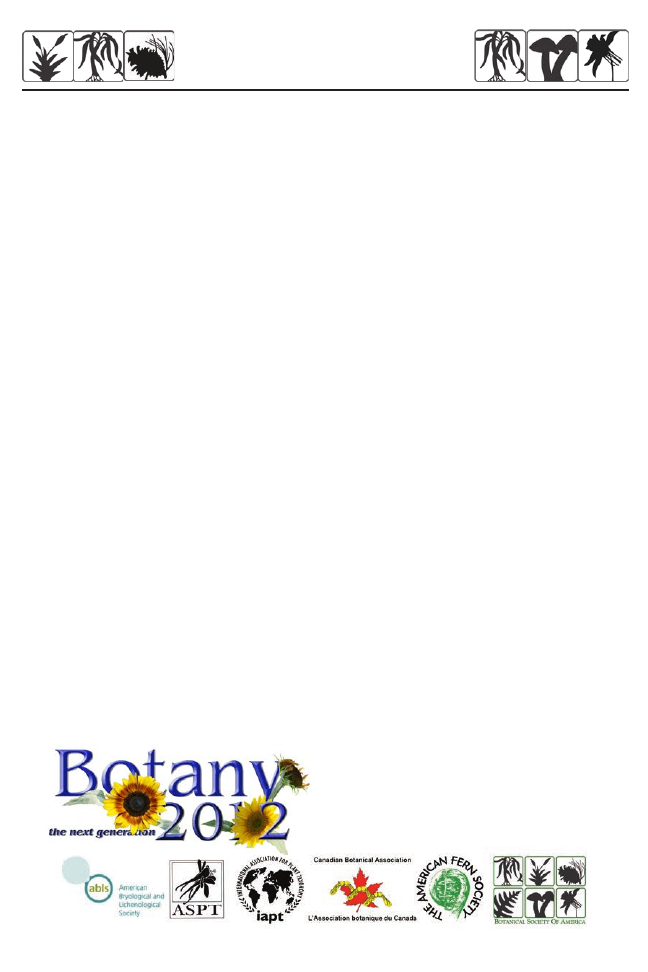
1
Table of Contents
www.botanyconference.org
Society News
Plant Science Research Summit .........................................................................................2
Saving Plants, Saving Ourselves .......................................................................................3
Legacy Society Celebrations. .............................................................................................8
BSA Science Education News and Notes
PlantingScience ..................................................................................................................9
Upcoming PlantingScience Summer Happenings ............................................................11
Focus Groups for PlantingScience Stakeholders..............................................................11
Of Special Interest to Advanced Placement Teachers ......................................................11
Education Bits and Bobs ..................................................................................................11
Climate Science Joins Evolution Teaching Advocacy ....................................................11
Just Average Among Global Education Systems ...........................................................11
Changing Budgets, Attitudes, and Technologies on Campus ..........................................11
Editors Choice Reviews
................................................................................12
Announcements
IN MEMORIUM Jerome E. Dimitman 1920–2011 .........................................................13
Martine Named Burpee Endowed Chair at Bucknell University .....................................14
Annual John Dwyer Lecture in Biology Features
Dr. Peter Wyse Jackson on Ireland’s Wild Plants ............................................................14
Missouri Botanical Garden Scientists Use Shrimp to Examine Toxicity of Traditional
Medicinal Plants in Northern Peru ...................................................................................15
Mycologist Charles Drechsler’s Papers to the Smithsonian Institution’s Biodiversity
Heritage Library ...............................................................................................................18
State Herbarium of South Australia Publications Now Online ........................................18
Second Interdisciplinary microMORPH Workshop: “Microevolution of Flower Form
and Function” ..............................................................................................................18
American Journal of Botany Hard-Copy Volumes for Donation .....................................19
American Journal of Botany Special Issue and Mobile Site ............................................19
Reports and Reviews
.....................................................................................20
Book Reviews
...............................................................................................24
American Journal of Botany Special Lecture at Botany 2012
......................34
Books Received
............................................................................................35
Plant Ed Images
............................................................................................36

2
Society News
Plant Science Research Summit
On September 22–23, 2011, the American
Society of Plant Biologists convened a Plant Science
Research Summit at the Howard Hughes Medical
Institute in Chevy Chase, Maryland. The BSA was
represented by President-elect Elizabeth Kellogg,
Past President Judy Skog, and Treasurer Amy
Litt. The goal of the meeting was to set priorities
for plant sciences research, with the hope that the
entire plant biology community could speak with
a single voice when approaching funding agencies
and governmental representatives, with an eye to
the upcoming budget process for 2013 and 2014
and years ahead. The meeting has been described
in Nature (2011, 477: 259) and Science (2011, 333:
1806, and http://scim.ag/plantplan).
Gary Stacey, of the University of Missouri,
convened the meeting and outlined the critical
importance of the plant biology community
working together. Funding for plant biology
research is about $350 million per year, an amount
just over one one-hundredth of the research
budget of the National Institutes of Health ($31.2
billion). If that dollar value is to increase, then plant
biologists need to have a focused message to send
to elected representatives. In one of the opening
talks, Barbara Schaal (Washington University)
distinguished clearly between grand challenges
(i.e., the big questions that drive any field of
research) and research priorities (specific goals
for immediate action). She noted that the goal of
this particular meeting was to set priorities, much
as the astronomy community does in its decadal
assessments.
The meeting focused particularly on securing
the food supply in coming years, although some
consideration was also given to the development
of biofuels. Keith Yamamoto, of University of
California–San Francisco, highlighted the need
for coordinated funding for plant science research.
David Fischoff, of Monsanto Company, observed
that much more biological insight is needed to get
the most out of plant breeding efforts; he highlighted
the importance of connecting basic plant research
to agricultural objectives and incorporating basic
research results into an industrial program.
Although the meeting included a handful of
talks, most of the time was spent in breakout groups
that used the talks as a springboard to develop the
necessary consensus document. The 75 attendees
included a broad mix of people with expertise in
cell and molecular biology, breeding, and genomics,
representing academic labs, government labs, and
industry.
If we are to make global improvements to
agriculture on the timescale required, clearly there
is a need for research on all aspects of plant biology,
but particularly focusing on the phenotype, in
the broadest sense. We still do not understand in
detail how plants respond to their environments
at the genetic or genomic level, what the role of
natural genetic diversity is, how plants function
in agricultural settings and natural communities,
how they react to pathogens, and how plant
characteristics can be modified to produce more
productive crops on limited land area.
There was some concern among the BSA
representatives that the focus on agriculture
came at the expense of other aspects of plant
biology, including areas that are the purview of
many members of the BSA, such as ecology and
evolutionary biology, although several speakers and
participants of the meeting noted the importance of
including these perspectives. This concern suggests
a couple of opportunities. For those of us who work
on wild plants, it may be worth considering whether
our work might be connected more directly with
the needs of agriculture. To choose a very simple
example, we know remarkably little about gene
flow via pollen or seeds in populations of wild
grasses, including agricultural weeds, yet clearly
this information is directly relevant to agronomy.
Likewise, even though the study of plant response
to drought is an important focus both in industry
and in cell and molecular biology, much remains
to be learned about how it is controlled, how it
evolved, and how it develops in nonmodel systems.
At the same time, there are a host of other issues
not directly connected to agriculture facing the
world for which knowledge of plant biology is
critical. Climate change is obvious. Conservation
is a continuing concern. These aspects of plant
biology will need to be articulated clearly.
A consensus document from the meeting is being
developed, and the organizers are planning ways
to solicit and incorporate broad input. When this
happens, I hope BSA will respond enthusiastically.
Any initiatives that support research on plants will

3
Plant Science Bulletin 58(1) 2012
benefit everyone, whether we do basic or applied
research. Those of us who attended will be watching
the results with interest and encourage all members
of the plant biology community to do the same.
–Elizabeth A. Kellogg, President-elect, BSA
Saving Plants, Saving
Ourselves
From the Plenary Address by Dr. Peter Raven,
Botany 2011, St. Louis, MO
Greetings everyone and welcome to St. Louis!
I am very pleased to welcome you here on behalf
of the Missouri Botanical Garden, Washington
University, the University of Missouri–St Louis,
St. Louis University, the Donald Danforth Plant
Science Center, Monsanto, Novus, and Sigma/
Aldrich, in addition to the many other plant-
oriented organizations that make St. Louis such an
outstanding center for the study and appreciation
of plants.
These outstanding Botany and Economic Botany
meetings, as such gatherings always do, will provide
a wonderful occasion for sharing information,
meeting new friends and colleagues, and making
plans for the future. I have been attending these
meetings and their precursors for more than 50
years, and have always found them interesting,
enjoyable, and worthwhile. I’m sure you will do the
same, whether you’re a first timer or an old hand!
Botany 2011 “Healing the Planet” promises to be a
memorable event for us all, and so it is appropriate
to pause and congratulate all who put this complex
meeting into place.
Specifically, I’d like to express on the behalf of
everyone here our gratitude to Bill Dahl, Executive
Director of the Botanical Society of America, who
with his associates and colleagues has done such
an outstanding job coordinating every aspect of
these meetings. As the week moves on, you will see
what an excellent job that has been! We welcome
you, hope that you will find these days relaxing,
enjoyable, and educational, and look forward to
welcoming you back in the future.
Now let’s move on to our theme of “Healing
the Planet.” In the early 21st century, anything we
say about life on earth involves some pretty tough
considerations about the problems that face our
common future.
Global population is a huge issue. When I was
born in 1936, there were about 2.2 billion people
on the planet. Right now, there are more than three
people living for each one who was alive when
I was born. The global population is projected to
reach 7 million by next spring (April 2012). By my
100th birthday, there will be four of us for every
one in 1936—one lifetime and a quadrupling of
population.
Every night when our collective humanity sits
down to dinner, there are 200,000 more mouths
to feed than there were the night before! The
global human population is projected to reach 9
billion by 2044. The population of Africa alone,
approximately 1 billion now, is projected to grow to
2 billion by 2050, and that of India from 1.2 billion
to 1.7 billion.
Of the world’s 7 billion people, about 1 billion are
so malnourished that their brains cannot develop
properly when they are babies and their bodies are
continually wasting away. Of these deprived people,
some 100 million are on the verge of starvation at
any one time.
For many women and children, there is absolutely
no chance of being accepted as full members of their
societies, and they grow up lacking both education
and opportunity. Making matters worse, we can be
certain that the 2.5 billion people being added to
the global population over the coming four decades
will almost entirely be among the poorest of the
poor, so that they will add greatly to the degree of
hunger and deprivation around the world.
Although we have little room in which to
maneuver, we still tend to act as if each one of us
is an exception, and that we, our families, and our
nation can simply continue somehow to do better
and better as time goes by.
Check the web site globalfootprint.org and
you will find a carefully reasoned estimate that
we are currently using about 150% of the world’s
sustainable capacity on an ongoing basis, up
from 70% 40 years ago. Putting this matter in
different terms, that means that in order to go
on supporting a world of 7 billion people, with 1
billion malnourished, sustainably—without driving
all the elements that support us to lower and lower
levels of sustainability---would require 1.5 times
the capacity of the planet that we inhabit. We
haven’t got that bigger planet: What are we going to
do about it? And how can the conditions of life on
earth actually be improved?
Clearly, we must achieve a stable population

4
Plant Science Bulletin 58(1) 2012
genetic diversity, and their habitats can only be
termed astonishing! It is so rapid that more than
half of all the species on earth could be permanently
gone by the end of the 21st century, an incalculable
loss that will deny many possibilities to ourselves
and all those who come after us, but one that we
are acting very tardily and indecisively to reverse.
The major factors involved are habitat destruction,
global climate change, the rapid spread of alien
organisms including pests and diseases, and the
overharvesting of selected species of plants and
animals for food, medicine, and other purposes.
What do we botanists have to contribute to
human welfare? We have historically assumed that
what we learn will enhance our prospects for the
future and perhaps help us find ways to lighten our
load on the earth. In that respect, we should be
pleased with our progress.
Personally, I entered university in 1953, the
same year in which Watson and Crick postulated
that DNA might be the genetic material. The first
transmission electron micrographs were being
produced, and people were scratching their heads
over the meaning of the structures that those
unfamiliar images revealed. Nothing about the
organization of cells was particularly clear, but
in very short order great discoveries were made;
our view of life became much sharper and more
detailed than we would have dared to imagine
earlier. Teaching biology at Stanford University in
the 1960s and writing the first edition of our text,
Biology of Plants, at the end of that decade, I soon
learned firsthand just how rapid was the progress
that we were helping to make possible. Eukaryotic
genetics, genomics, proteomics, complex systems
theory, the whole unfolding of ecology as we know
it today—those have been among the intellectual
advances of great importance that took place
during the course of my professional career. Our
book was intended to apply the newly discovered
basic biological principles directly to the study of
plants so that we could take advantage of the new
information in understanding plants as completely
as possible.
Partly as a result of the trends just reviewed,
many of us worry that our science—botany—
has been dying over the past half century. I don’t
agree, and believe that our answer must be highly
qualified and nuanced to reflect accurately what has
taken place and where we are headed. Traditional
botany departments, separate academic entities,
slowly began to absorb the remarkable findings
of the new biology. Their curricula tended to
remain traditional and they were sometimes slow
level, accept a justifiable level of consumption for
everyone worldwide, and develop a whole array of
new technologies that can help us do more with
less. Getting there will involve empowering women
and children in all societies and striving to make
it possible for every single human being to express
his or her own abilities fully for their own benefit
and for our common welfare. Although these goals
may seem utopian and wholly visionary, we have no
moral alternative to pursuing them as vigorously as
we are able.
Everyone here knows that plants and other
photosynthetic organisms have a major role to play
in the solution to the dilemma we face together.
They provide all our food, more than half of our
medicines worldwide, clothing, building materials,
chemical feedstocks, possible renewable sources of
energy, as well as ecosystem services of inestimable
value. They fill our lives with beauty and hope,
and have inspired artists throughout the course
of human history. Our opportunities to build a
sound and sustainable future rest implicitly on the
characteristics of the living world; nothing else is
truly sustainable.
Countering our dreams and aspirations, we are
driving to extinction a major proportion of all life
on earth, and doing so more rapidly than at any
time for the last 65 million years, since the end of
the Cretaceous Period. To the extent that we can
estimate it, the rate of biological extinction has
climbed by several orders of magnitude over the
past 10,000 years or so, since our ancestors first
domesticated plants and animals and launched the
agricultural revolution that was to make possible a
massive and lasting explosion of human population
levels. This explosion took us from a level of several
million people 10,000 years ago (only about 400
generations)—widely scattered bands of hunter-
gatherers—to a rapidly growing 7 billion today, with
such profound effects on the earth that people are
starting to consider that we have entered a wholly
new geological period, the Anthropocene, a period
in which we are dominant to an unbelievable extent,
modifying our home planet and destroying its life
systems wantonly and mostly without focusing on
the problems for which we are responsible.
With a third of the world’s land surface cultivated
or grazed by domestic animals and every square
centimeter of the land affected directly by the
activities of human beings, we are clearly moving
rapidly toward the creation of a world that is less
diverse, more uniform, and with many fewer
possibilities than the one into which we were born.
The rate at which we are destroying species, their

5
Plant Science Bulletin 58(1) 2012
to grasp the importance of what was going on. As
time went by, the core of biology—how cells and
molecules function; how living organisms achieve
their remarkable, diverse forms; and indeed, how
simple some of the basic principles were when we
understood them properly—expanded, and all
biologists had to assimilate a large core of material
to understand the basics of the field. To teach these
principles well in a series of separate departments
came to seem less and less reasonable, and fused
departments were formed at an ever-increasing
rate. What is distinctive about plants in their
growth patterns, hormones, secondary metabolites,
patterns of diversity, and place in ecological systems
is not the basis for understanding their cellular
and molecular biology but rather a set of features
based on those basic biological principles, which it
therefore began to seem logical to teach first.
As botany departments were merged into more
comprehensive biology departments, a strange thing
began to happen! Where the original departments
often contained mycologists, bacteriologists,
ecologists, and many other kinds of biologists, once
the mergers had taken place, they were no longer
“counted” as botanists—a very narrow definition
was used to conduct a head count of the remaining
plant scientists. No wonder we botanists feel that
we have been disappearing so rapidly!
Against this background, however, it is
important to emphasize the fact that relatively
little scientific emphasis has been placed on the
special features of plants as opposed to microbes
and animals, regardless of departmental structure.
During the past 30 years or so, plant studies have
been strengthened considerably, and we have
learned a great deal about plant biology. Mary
Clutter, who will speak at these meetings, deserves
a great deal of credit for her role at NSF in making
possible increased funding for the plant sciences,
including the initiation of the highly productive
plant genomics program. And there have been
many other instances in which our knowledge
of plants and how they function has expanded
beyond anything that we could have imagined
when I was starting my own university career
nearly 60 years ago. Virtually the whole field of
ecology has developed during this period, leading
to a realization of the ways in which ecosystems
function and the complex and largely unknown
interactions by which they function sustainably.
We now understand plant growth in a depth that
would have seemed impossible to attain a few
short years ago, and outstanding new findings are
accumulating monthly.
Important advances have been made in our
understanding of the evolutionary relationships of
photosynthetic organisms, the effort epitomized by
the Tree of Life program [http://tolweb.org/tree/]
funded by NSF and early spurred by the realization
that prokaryotic and eukaryotic organisms
differed fundamentally, then by the discovery of
Archaea, and finally by the demonstration that
plastids, mitochondria, and other organs in the
cells of eukaryotes had originated following the
incorporation of symbiotic prokaryotes with
eukaryotic cells. Genome comparisons, now
commonplace and destined to become much more
so in the future, have revealed the evolutionary
relationships of plants to a degree that was
unthinkable only a couple of decades ago, and the
remarkable trail of discovery leads on and on to still
more exciting findings.
It was dogma when I attended university in
the 1950s that the fossil record would never yield
much information about the evolutionary history
of plants—but were we wrong! The wonderful
findings made by members of our societies and their
colleagues around the world have revealed much
more than we ever thought it possible to know. For
angiosperms, new techniques have allowed Peter
Crane, Else Marie Friis, and their associates to trace
the evolution of the early members of this group
through a thorough examination of their tiny fossils
using the most modern techniques. Many exciting
paleobotanical results are being published, and the
flow is expected to continue indefinitely.
If the knowledge of plants is moving ahead so
rapidly, why do we feel that the science of botany
is faltering? There are many reasons, some having
to do with the naming of departments and courses,
and some having to do with the explosive growth of
molecular and cellular biology on the one hand and
ecology on the other. These sciences contributed
directly to advances in botany, but do not seem like
the traditional botany that we look back to with
nostalgia. In those respects, we’ve got to get over it,
enjoy what is being discovered, and incorporate the
new findings into our teaching and our thinking.
What is certainly tending to be lost, however,
is the ability to recognize and deal with plants
and other kinds of organisms in nature. Courses
in plant identification have become rare, even in
land-grant universities, and it is no longer clear
where those who have the ability to recognize
and name plants will be trained. There are far
more members of the American Society of Plant
Taxonomists now than there were when I was a
student, but their specializations are diverse, and

6
Plant Science Bulletin 58(1) 2012
many cannot recognize many kinds of whole plants
as organisms. Nevertheless, that kind of knowledge
is badly needed in our rapidly changing world, and
we must find new ways to increase the number of
people trained in the area of plant identification
and traditional taxonomy. Perhaps such training
should take place at the high school level; perhaps
botanical gardens and museums should play a
greater role in it. Whatever the case, we need to do
more than is currently being done.
As an aside, why does it seem that there are so
many fewer taxonomists now, when in fact there
are more? Several reasons are clear:
In 1965, it was estimated that the total number of
organisms worldwide was less than 2 million, with
perhaps 1.4 million known. The current estimate
is 12 million eukaryotes and an unknown but
enormous number of prokaryotes. Are we up to the
task?
In 1965, the standard estimate of the number
of angiosperm species was about 235,000; now,
following the organization of The Plant List [http://
www.theplantlist.org/], it is about 350,000 or more,
with perhaps 75,000 still to be discovered and
described.
We depend on our ability to deal with species as
part of the solution to the problem of achieving a
sustainable earth, and yet our knowledge base is
unsatisfactory and growing very slowly.
Species are becoming extinct at an enormous
rate, so that our chance of learning about them or
even knowing they are here is vanishing.
Universities and colleges appoint few systematists
and train few students in this area; thus, there is no
clear plan for training the people that the world
needs to address the problems of a disintegrating
global ecosystem.
At this point I feel compelled to put in a
strong plea for a much stronger common effort
to study and understand those organisms that
have traditionally been grouped with plants, such
as the fungi. Along with the bacteria, fungi are
the decomposers of the biosphere, of extreme
importance both ecologically and economically,
and of enormous diversity, and yet very few people
study their taxonomy. The Tree of Life Program
has helped, but we need more people who can
simply recognize them, evaluate them—find out,
for example, how many species are represented
by hyphae at a series of specific localities and how
many of them form spore-forming bodies—and
answer such questions as how does fungal diversity
contribute to the functioning of ecosystems, how
do lichens work, where are species of fungi most
abundant, and many other questions. The curricula
in biology departments ought to allow more
attention to be paid to these important organisms,
but the trend is not particularly evident yet. Many
more universities should find important specialties
here. What can each of us do locally in this respect?
Concluding Remarks
I first realized that the world was under threat
in the mid-1960s, and had no idea before that
time that by now we would be destroying habitats,
drastically and rapidly altering the global climate,
and consuming all of our planet’s resources much
more rapidly than they can be replenished. In the
face of this crisis, we need to make serious choices
about what we can accomplish and select our goals
carefully. Our future food supplies, medicines,
climate stability, protection of topsoil, and the
provision of clean water, as well as the rich beauty
that plants bring into our lives every day, are worth
fighting for. What can we do as plant scientists and
as people to make the future better?
In the United States, we can work to improve
education and especially to help people understand
how science works. Our country is the only one in
the world in which a great number of people do
not accept evolution as the basis for the diversity
of life on earth. We are the only nation in which
an organized political movement claims not to
“believe” in global warming and the effects of the
human drivers associated with it. As scientists and
concerned citizens, we should do whatever we can
to help people understand the facts of our situation,
because they don’t know how science works. In
1991, Stephan Schmidheiny, a Swiss businessman,
pointed out in the Op Ed pages of the New York
Times that there was no greater gift that Americans
could give to European and Japanese industry than
to go on claiming that global warming did not
exist—and that was 20 years ago!
Recently a scientist was asked whether he
“believed” in global climate change or not. He
replied along these lines:
“No, I reserve belief for important things like
religion. Global climate change and the key role of
human beings in causing it is a scientific conclusion
based on thousands of peer-reviewed papers over
the years. These papers and the information that
they analyzed eventually led to a consensus that
reflects the current state of scientific understanding.
Belief has nothing to do with it.”
He might have added that neither do the views
of those in the media or in Congress who refuse

7
Plant Science Bulletin 58(1) 2012
to deal with the science of the situation, instead
making assertions for whatever their own purposes
may be. Science doesn’t tell us what to do, but if
we’re contemplating jumping off a 20-story building
it would seem prudent to take into account what
science tells us about what the consequences are
likely to be.
St. Augustine, the Christian bishop of what is
now part of Algeria in the 5th century, cautioned
believers against a blindly literal interpretation
of the Bible. He clearly understood that the Bible
was a way of explaining the world in terms that
were familiar to those writing it. What we now
consider the literal interpretation of the Bible
largely gathered strength in the United States in
the early 19th century, and it has led to exactly
the sort of nonsense that St. Augustine warned
against 1500 years ago. Thus we miss the fact that
educated people generally accepted evolution as
the only plausible explanation of life on earth long
before Charles Darwin proposed a mechanism for
it. Many believers understand that a Supreme Being
can be understood as operating through what we
see as the laws of nature, and not by individual
creation of millions of species everywhere through
all time. As Charles Darwin, who was certainly a
believer, wrote in On the Origin of Species…,
“It is interesting to contemplate a tangled bank,
clothed with many plants of many kinds, with
birds singing on the bushes, with various insects
flitting about, and with worms crawling through
the damp earth, and to reflect that these elaborately
constructed forms, so different from each other,
and dependent upon each other in so complex a
manner, have all been produced by laws acting
around us. “
In addition to doing whatever we can to help our
fellow students understand the scientific method,
we can help promote an international viewpoint.
Why is the United States, which depends on every
nation on earth for our economic situation, the
lowest per capita donor of economic development
assistance of any industrialized nation? Why do we
virtually bar family planning assistance to other
countries when we have the most to lose if they
don’t adopt means for family planning that are
perfectly legal both here and there? How can we
care about the people of other countries if we don’t
even recognize the fact that they exist? We must do
a great deal better, recognizing more fully the needs
of the poor and needy even in the places where we
live and extending to them the love and charity
that may seem altruistic but in fact ultimately make
possible a sustainable future for us all.
One of the most important things we can do is
to promote environmental education for all. Over
the next 40 years, we will add 2.5 billion people,
mainly hungry, to a world that already includes 2
to 3 billion people living in extreme poverty; we’ll
drive to extinction perhaps 10–20% of all living
things on earth, altering permanently the future
prospects both for our planet and for the human
race; we’ll warm the climate by several degrees
Fahrenheit and raise the sea level by more than
a foot; water will become a source of contention
throughout the world; and environmental factors
that we cannot even comprehend now will surface
like the Great White Whale to threaten our ability
to achieve a sustainable life, filled with opportunity,
for ourselves and our children.
Why for heaven’s sake don’t we make basic
literacy in environmental science fundamental
in K–12 education, and a requirement for all
university graduates, unless we think they are going
to be able to steer their lives though these factors
by reading snippets of coverage in the media after
the events have taken place? Please take some
time to work for these causes in the areas where
you live: the rewards are of the most fundamental
importance for building a sound future.
Having taken this knowledge on board, we have
an obligation to spread the word to our students,
families, fellow citizens, voters, co-religionists,
everyone—to urge them to learn, to act, and to
vote. As we pursue our science, confident in the
knowledge that it will enrich our possibilities for
the future, we must also work to understand the
overall dimensions of the world in which we live
and use that knowledge to strive for a better, more
equitable, sustainable, and peaceful future. We must
play our individual and special roles in choosing
goals for ourselves, our communities, our nation,
and the world, establishing priorities and pursuing
them actively. We botanists, who know better than
most, must use our knowledge and our training
to educate our fellow citizens, especially children,
and work to maintain a world that is filled with
opportunity, diversity, and beauty. As scientists,
as citizens of the wealthiest and most privileged
nation on earth, and as global citizens, let’s strive
to act in ways compatible with the privileges and
opportunities that we have been given.
-Peter H. Raven, Missouri Botanical Garden, P.O.
Box 299, St. Louis, MO 63166

8
Plant Science Bulletin 58(1) 2012
Legacy Society
The BSA Legacy Society is hosting a Legacy Society Celebrations event at
the Chase Park Plaza Hotel, in St. Louis on April 14, 2012
What is this all about?
A few years ago, members of the Botanical Society of America celebrated our first 100 years
as a professional Society. Looking back over the past century, it was so encouraging to see
how our support for botanical research and education clearly added to the depth of scien-
tific knowledge worldwide. Shortly after our celebration, the
American Journal of Botany
was named one of the top ten most influential journals over the last 100 years in the field
of Biology & Medicine, based on the survey by the BioMedical & Life Sciences Division
(DBIO) of the Special Libraries Association (SLA).
We have much to celebrate.
During our centennial celebrations in 2006, senior members decided it was time we build
upon the important legacy of those who went before to ensure a solid foundation for the fu-
ture of the BSA. They formed the Legacy Society, an active group focused on ensuring a
sustainable financial future for the Society. Over the past five years, the Legacy Society has
quietly grown to over 70 members — and we would like to provide a better understand-
ing of the important contributions of our Legacy Society to all BSA members, while we cel-
ebrate our contributions to Botany and the broader scientific community.
Why become involved?
Who is a member of the Legacy Society?
How can I support the BSA?
Visit the website at: http://botany.org/legacy/index.php
This first Legacy Society Celebrations event is an evening for celebrating the onset of the
centennial of the
American Journal of Botany and the many important contributions made
our members. Please RSVP by March 23, 2012 as seating is limited! If you have not yet
received your invitation and would like one, please contact bspears@botany.org
5:30 - Cocktails and Introduction by Dr. Peter Raven
6:15 -
AJB Retrospective honoring AJB Editors by Betty Smocovitis & Judy Jernstedt
6:30 - Seated Dinner
7:15 - Special Presentation by Allison Miller
8:00 - Concluding comments by BSA President, Dr. Stephen Weller, & Development
Committee Chair, Dr. Linda Graham
We look forward to celebrating with you!
- Bill Dahl

9
BSA Science Education
News and Notes
PlantingScience
January is National Mentoring Month (http://
www.nationalmentoringmonth.org/). This is a
timely opportunity to recognize and celebrate the
many mentoring activities of BSA members: as part
of your everyday work life guiding undergraduate
and graduate students and postdoctoral researchers
in your institution; as outreach with youth in your
local community; and as service in society efforts
to strengthen participation in the discipline. Your
diverse mentoring activities may vary substantially
in the who, when, and where of mentoring.
Answers to the question of why do it, however,
likely converge on the desire to make a difference
in the lives of others and give back to the science
community. While the research on mentoring
is somewhat limited, it is safe to say that mentors
matter.
The focus of this update on PlantingScience
activities is to take a look at the online mentoring
in the program. Over 900 scientists have signed
on to volunteer as online mentors guiding the
science discovery of student teams in the course
of their plant investigations. Mentors represent
14 partner societies (American Bryological and
Lichenological Society, American Fern Society,
American Institute for Biological Sciences,
American Phytopathological Society, American
Society of Agronomy, American Society of Plant
Biologists, American Society of Plant Taxonomists,
Botanical Society of America, Canadian Botanical
Association, Crop Science Society of America,
Ecological Society of America, Society for Economic
Botany, Society for the Study of Evolution, and
Soil Science of America), as well as government
agencies and diverse career paths in plant science.
The remarkable interest in PlantingScience
mentoring is a testament to scientists’ commitment
to the cause of building science literacy and interest
in plants. Scientists who volunteer in the program
receive the PlantingScience mentor guide, and also
bring the mentoring skills they’ve developed in
other contexts.
BSA Science Education News and Notes is a quarterly update about the BSA’s education efforts and the
broader education scene. We invite you to submit news items or ideas for future features. Contact: Claire
Hemingway, BSA Education Director, at chemingway@botany.org or Marshall Sundberg, PSB Editor, at
psb@botany.org.
How do PlantingScience mentors offer guidance
to student teams in online collaborative science
learning? This is one question the program
is examining in order to identify patterns of
interactions and evaluate kinds of supports for
student-teacher-scientist partnerships. We are
viewing the online postings between scientists and
their student teams through research frameworks
on mentoring and science discourse. With an
average of 200 scientists taking part in each online
mentored inquiry session and two sessions offered
each year since 2006, the program is data rich!
Preliminary categorization of how mentors talk
with student teams in the most recent session
suggests that PlantingScience mentors see the
complex interplay of social functions along with
supporting student thinking about how science
and plant biology work. The majority of mentors
offer grade-level-appropriate comments in an
encouraging and respectful tone that helps build
a relationship with students. They ask students
questions that prompt students to reflect and think
critically, as well as offer suggestions and feedback
on the team’s investigation. When conversations
really click, the ability of scientists to stimulate
student excitement and elevate student thinking
is the unmistakable magic of mentoring. Broad
categories are also emerging for the general
functions of comments made by mentors and the
specific tools and techniques they employ (See table
on the following page).

10
Plant Science Bulletin 58(1) 2012
Conversation Function
Mentoring Actions or Techniques
Brokering expectations and building
relationships
Affirming, encouraging.
Providing information about themselves.
Asking for information about team.
Helping mentees to gain access to resources
Providing factual information, content
knowledge, or research tools.
Pointing to places for students to seek these.
Helping mentees to clarify their goals or
intentions
Checking for understanding; restating ideas.
Asking directly or indirectly for information.
Asking “have you thought about..”
Training or instructing through how-tos.
Providing factual information, content
knowledge, or research tools.
Explaining.
Prompting new connections of ideas.
Helping mentees to troubleshoot problems or
address group issues
Helping mentees to clarify procedures or
processes
Helping mentees to clarify ideas
Helping mentees to reflect on understandings
Presenting hypotheticals, scenarios, or
analogies.
Encouraging real world connections and
applications.
Asking probing questions that encourage
student metacognition (thinking about
thinking)
Socializing mentees into the culture of
science
Role modeling—providing information about
their own life as a scientist.
Talking about career pathways, history of
science, how science is done.

11
Plant Science Bulletin 58(1) 2012
Upcoming PlantingScience
Summer Happenings
Focus Groups for PlantingScience
stakeholders
This is an active phase of working on website
improvements and developing future plans for
PlantingScience. We plan to host stakeholder
meetings to make sure that, in visioning the next
phase of the program, we are meeting the needs
of our community and gathering insights from
teachers and scientist mentors. We will hold a
summer focus group meeting in association with
Botany 2012 and also plan a fall focus group meeting
in association with the National Association of
Biology Teachers meeting.
While we can’t invite all past participating mentors
and teachers to attend the focus groups, we do
value and seek your input. Don’t hesitate to share
your thoughts anytime! Email us at psteam@</p>
plantingscience.org.
Of special interest to
Advanced Placement teachers
Join in a botany-themed session at this
summer’s AP Conference (July 20-21, Lake Buena
Vista, Florida). Naomi Volain, who has been a
PlantingScience teacher since participating in
the first summer institutes for teachers held in
2008, will be leading Plants as Pedagogy: Botany
Directed AP Environmental Science.
Education Bits and Bobs
Thinking Evolutionarily
Convocation
“Nothing in biology makes sense except in the
light of evolution.”
This famous 1964 quote by Theodosius
Dobzhansky frames current national efforts
to incorporate evolution as a central theme in
teaching biology in both pre- and postsecondary
levels. The National Research Council’s Board
on Life Sciences and the National Academy of
Sciences held a convocation in Washington,
D.C., on October 25-26, 2011. BSA member
Gordon Uno was among the committee members,
convocation presenters, and panelists collaborating
with stakeholders to develop a strategic plan to
infuse evolution education across the life sciences.
Convocation presentations are available online.
The website also has diverse resources on policy,
research, curriculum guides, videos, and websites
for teaching and learning about evolution.
To learn more, see: http://nas-sites.org/
thinkingevolutionarily/.
Climate Science Joins
Evolution Teaching Advocacy
The National Center for Science Education
(NCSE) is renowned for taking on the creationism
controversy and defending evolution teaching
in U.S. classrooms. As with evolution, the topic
of global warming in the classroom can trigger
socially and politically charged responses rather
than a focus on the climate science research. So,
in 2012 the NSCE added a new advocacy goal to
provide information and resources for teaching
about climate change. One of the new tools
addresses the false pillars of climate change deniers.
Resources for taking action are also provided.
Read a 16 January 2012 news article in Nature
Vol. 481 at http://www.nature.com/news/evolution-
advocate-turns-to-climate-1.9811.
Visit the National Center for Science Education
website at http://ncse.com/.
Just Average Among Global
Education Systems
Education, particularly science and math education,
is often closely linked to a nation’s competitive status.
In its annual survey,
Education Week’s
Quality Counts
report for 2012 critically examines American education
from a global perspective, along with its usual state
report card on academic performance. Overall, the
United States received a C. State-by-state scores ranged
widely on indicators: the Chance-for-Success Index;
the K-12 Achievement Index; standards, assessments,
and accountability; school finance; policies toward
the teaching profession; and policies toward the
educational continuum. Math and science were the
subject areas most strongly influenced by international
standards and examples of excellence.
Access the report and state scores at http://www.
edweek.org/ew/toc/2012/01/12/index.html?intc=EW-
QC12-LFTNAV.
Changing Budgets, Attitudes,
and Technologies on Campus
How do tuition hikes and diminished resources
on your campus compare to other colleges and
universities? The Chronicle of Higher Education’s
Almanac of Higher Education 2011 provides an
annual overview on the institutional financial
strategies, academic pay, student demographics,
and attitudes, access and equity and technology,
among other data, for higher education institutions
across the United States.
To view the 2011 summaries or search the data,
see: http://chronicle.com/section/Almanac-of-
Higher-Education/536/.

12
Manipulatives-Based Laboratory
for Majors Biology: A Hands-on
Approach to Understanding Respira-
tion and Photosynthesis
S. Boomer and K. L. Latham
Journal of Microbiology and Biology Educa-
tion 12(2): 127–134.
Have you noticed that students in introductory
biology show the least interest in and score the
lowest on exams and labs on metabolic processes
including respiration and photosynthesis? Those
findings prompted the authors to try a new approach
in laboratory exercises. Students manipulating
paper cutouts, movable blocks, and LEGOs to
model electron transfer and reactions within cells
showed significant gains in understanding. And a
remarkable 33% of students rated metabolism as
their favorite topic at the end of the course.
Rainforest Depiction in Children’s
Resources
J. Dove
Journal of Biological Education 45(4):
208–212.
Misconceptions about the natural world can be
generated from the most innocent of areas: children’s
literature. As most children in North America and
Europe have no firsthand experience of a rainforest,
their impressions come from the ways rainforests
are presented in media to them. An analysis of
20 books and 12 websites designed for students
aged 9–14 documents the over-representation of
big, colorful, endangered, or dangerous animals.
Perspectives on plant life emphasized large, rare,
and colorful plants and vertical stratification of the
forest.
Exploring the Complexity of Tree
Thinking Expertise in an Undergrad-
uate Systematics Course
Kristy L. Halverson, Chris J. Pires, and Sandra
K. Abell
Science Education 95: 794–823.
This is not a “how to” for implementing tree
thinking in a course, although there are plenty of
Editors Choice reviews
examples that can be employed. Rather, it confirms
some misconceptions already in the literature and
identifies some new ones. More importantly, the
authors then identify a variety of approaches to
remediate persistent nonevolutionary reasoning,
based on a classification of student reasoning
types they develop. This is a great example of
the effectiveness of using qualitative assessment
to improve student learning on one of the most
challenging topics in biology.
Using Soil Seed Banks for Ecological
Education in Primary School
E. J. Ju and J. G. Kim
Journal of Biological Education 45(2): 93–101.
Looking underground might seem a surprising place
for students to begin their studies on relationships
between local plants and the environment. Soil
seed banks, however, give students context for
their ideas about plant distribution and ecology.
This comparison of fourth graders in South
Korea demonstrates enhanced understanding and
attitudes about plants for those students doing a
series of hands-on activities. Sampling the soil seed
bank, identifying seeds, and making observations—
these activities can be successfully sequenced for
active learning at any grade level.
Can Dynamic Visualizations Improve
Middle School Students’ Under-
standing of Energy in Photosynthe-
sis?
K. Ryoo and M.C. Linn
Journal of Research in Science Teaching 49(2):
218–243.
Innovative approaches to teaching conceptually
difficult topics like photosynthesis are needed at
all education levels. These authors compared the
use of dynamic versus static visualizations among
7th graders completing a Web-based inquiry
on energy concepts in photosynthesis. Student
understandings of abstract concepts are much more
effectively improved with dynamic visualizations.

13
ANNOUNCEMENTS
IN MEMORIUM
Jerome E. Dimitman 1920–2011
Jerome (Jerry) Dimitman, beloved Professor
Emeritus and long time Chair of Biology at Cal Poly
Pomona, died on 14 December 2011 at age 91. He
was a plant pathologist, botanist, and horticulturist.
He spent a great deal of his life studying citrus
diseases, culminating in the Lifetime Achievement
Award from the California Citrus Research Board.
Jerry was born in New York City, where he
enjoyed growing plants in his window boxes.
When he was 18 years old he moved to Southern
California, where he attended Los Angeles City
College. He later earned a Bachelor’s degree in
Botany (1943) and a Master’s degree in Plant
Pathology and Entomology (1949), both from UC
Berkeley. Dimitman received his Ph.D. in plant
pathology and biochemistry from UC Riverside in
1958. His formal education was interrupted more
than once by notable service as a naval commander
during both World War II and in the Korean War,
during which time he developed an enduring
interest in Asian culture and also a love for Asian
fruits, which he cultivated for much of his life.
Jerry had a tremendous impact on the culture of
the Department of Biological Sciences. He began
teaching at the Voorhis campus in San Dimas in
1948, and was one of the founding members of the
biology faculty as the Voorhis campus transformed
to become Cal Poly Pomona. When Jerry began as
a professor at Cal Poly Pomona, he also served for
several years as the coach of the track team, and
he became the first ever coach of the cross country
team. Jerry was an engaging coach, mentor, and
teacher to students and faculty alike. Jerry had
many international collaborations and he was a
wonderful teacher-scholar. Former students, faculty
members, and his family members remember with
fondness going on field trips with Jerry to Mexico
and other countries; he was well known for veering
suddenly off the road to inspect rare and interesting
plants that he noticed out of the corner of his eye.
He also enjoyed meeting and socializing with “the
locals” wherever the field site. Jerry was proud
of the fact that he effectively encouraged many
students to go on to advanced degrees, and many of
his former students and athletes stayed in contact
with him throughout his life.
Jerry served as chair of the Biology Department
for 12 years, during which time he oversaw a
growing department, with the hiring of a diverse,
international, research-active faculty that was well
known for obtaining external funding to support
research and curriculum development. He helped
to develop many academic programs including
an undergraduate major in Botany and the first
Master’s program on the Cal Poly Pomona campus.
By all accounts he was a great advocate for students
and faculty alike. Although Jerry retired in 1983, he
continued to teach at Cal Poly Pomona until 1990.
In his retirement, Dimitman continued to
grow many rare varieties of Asian fruits, such
as pummelos, lychees, longans, wampi, and
mandarins, and he enjoyed selling them at a
local farmers market, where long lines of Asian
customers, many of them close friends, eagerly
awaited the delicacies. Two of his most prized
varieties were the Chong and Wong pummelos,
which he named after his dear late friends Chong
Lew and Ben Wong.
Jerry served for many years as a consultant
in plant pathology and education in Greece,
Guatemala, Yemen, China, South Africa, and
other countries. He served on many research
boards for fruit companies and cooperatives. He
spent 11 years as a scientific consultant and nine
years on the Board of Directors of the California
Citrus Research Board. The Board later named
the Riverside Research facility the Jerry Dimitman
Laboratory, in his honor.
Jerry died of a stroke in his home at one of his
two exotic fruit ranches in Southern California. He
is survived by his wife, Emma Ureta-Ruiz, his sons
Steven and Robert, his daughter Susan Purdy, and
his sister Elaine Henley, M.D.
-Frank W. Ewers, Cal Poly Pomona, Pomona, CA 91768

14
Plant Science Bulletin 58(1) 2012
Martine named Burpee
Endowed Chair at Bucknell
University
Botanist to join Department
of Biology
LEWISBURG, PA—Chris Martine has been named
the next David Burpee Chair in Plant Genetics
and Research at Bucknell University. He will join
Bucknell in July as a professor in the Department
of Biology.
For the past six years, Martine has been a professor
of botany at the State University of New York
(SUNY) College at Plattsburgh. During his time
there, he helped create the first student chapter of
the Botanical Society of America and established
the only Botany minor available among the 18
four-year SUNY schools. In 2011, Martine was
presented with a SUNY Chancellor’s Award for
Teaching Excellence, one year after being selected
for the Charles Edwin Bessey Teaching Award by
the Botanical Society of America, or BSA.
Martine received his bachelor’s degree in Natural
Resource Management from Rutgers University in
1996. He received his master’s degree in Ecology
and Evolution at Rutgers in 2001 while working as
a science educator for the New Jersey Forest Service
and the Mercer County (N.J.) Soil Conservation
District. In 2006, Martine earned his doctorate in
Botany from the University of Connecticut. While
a student at UConn, Martine won graduate student
research awards from the BSA and the American
Society of Plant Taxonomists. The latter society
also selected him for the George R. Cooley Award
in 2005.
Martine is author or co-author of two books, a
dozen peer-reviewed publications, and more than
50 conference abstracts. He serves on the New
York Flora Association Board of Directors, the
Plant Science Bulletin Editorial Board, and the BSA
Education Committee.
Martine is extensively involved with community
outreach and has developed a set of YouTube videos
that teach the public botanical principles in fun
ways—including the first episode of the new series,
“Plants Are Cool, Too!”
The David Burpee Chair in
Plant Genetics
The David Burpee Chair
was established
in 1983 through the generosity of David
Burpee, a Bucknell trustee for more than 40
years. The Chair has been held by Professor
Warren Abrahamson since its inception.
Abrahamson will retire in June after an outstanding
career that began at Bucknell in 1973. His teaching
has been recognized with two awards from
Bucknell University. His service to conservation
was recognized with a Lifetime Achievement
Award from the Merrill Linn Land and Waterways
Conservancy and a William Dutcher Award for
Outstanding Service to the Audubon Cause at the
Regional Level (Mid-Atlantic Region).
Annual John Dwyer Lecture
in Biology Features
Dr. Peter Wyse Jackson on
Ireland’s Wild Plants
ST. LOUIS, MO—Join the Missouri Botanical
Garden for the 2012 John Dwyer Lecture in
Biology on Friday, March 9 at 4 p.m. In advance of
St. Patrick’s Day, Dr. Peter Wyse Jackson, Garden
president and Ireland native, will present “Ireland’s
Generous Nature—The Use of Wild Plants in
Ireland through the Ages.” The event is free to
attend and open to the public.
Wyse Jackson has undertaken extensive research
on the use of wild plants in Ireland. His lecture will
outline the ways in which a wide variety of plants
have been a fundamental part of life for people in
Ireland for centuries, tracing the history of plants
used for food, medicines, fibers, fuel, and timber
since the earliest times. Hear fascinating stories
associated with plant use, including how the potato
shaped the Ireland of today, how cereals were used
to make poteen (illegal moonshine), and how
plants were used as the raw material for thatching

15
Plant Science Bulletin 58(1) 2012
houses and for ancient pagan rituals that survive up
to the present day.
Born in Kilkenny, Ireland, Wyse Jackson studied
botany at Trinity College Dublin, where he
subsequently obtained a Ph.D. for work on the
taxonomy of Irish Cruciferae. In 1981, he was
appointed curator of the Trinity College Dublin
Botanic Garden. In 1987, he moved to Kew in
England to join the International Union for the
Conservation of Nature (IUCN), where he helped
to establish the international network organization
for botanic gardens that became Botanic Gardens
Conservation International (BGCI). In 1994, he
was appointed secretary general of BGCI and in
2005 returned to Dublin as director of the National
Botanic Gardens of Ireland. In 2010, he was
appointed to his present position at the Missouri
Botanical Garden.
As one of the world’s foremost and best known
botanists and plant conservationists, Wyse
Jackson has played an influential role in reshaping
and leading the international botanic garden
community over the past two decades. He has
worked extensively with botanic gardens and
their network organizations worldwide, helping
to establish or develop botanic gardens and other
organizations in over 30 countries. He played a lead
role in the development and implementation of the
Global Strategy for Plant Conservation, adopted
by the U.N. Convention on Biological Diversity
in 2002, and has been chairman of the Global
Partnership for Plant Conservation since 2005.
The annual John Dwyer Lecture in Biology honors
the memory of Dr. John Dwyer, a professor of
biology at Saint Louis University and former
research associate of the Missouri Botanical
Garden.
The lecture will be held in the Shoenberg Theater
of the Ridgway Visitor Center at the Missouri
Botanical Garden. The Garden is located at 4344
Shaw Blvd. in south St. Louis, accessible from
Interstate 44 at the Vandeventer exit and from
Interstate 64 at the Kingshighway North and South
exit. Free parking is available on site and two blocks
west at the corner of Shaw and Vandeventer.
Missouri Botanical Garden
Scientists Use Shrimp
to Examine Toxicity of
Traditional Medicinal Plants
in Northern Peru
One Quarter of Water Extracts and
Three Quarters of Alcoholic Extracts
From 341 Medicinal Plants Had Toxic
Side Effects
ST. LOUIS, MO—Many developing countries
rely on traditional medicine as an accessible and
affordable treatment option for human maladies.
However, until now, scientific data have not existed
to evaluate the potential toxicity of medicinal plant
species in Peru. Scientists from the William L.
Brown Center of the Missouri Botanical Garden
in St. Louis led a study using brine shrimp to
determine the toxicity of 341 northern Peruvian
plant species commonly ingested in traditional
medicine. Their findings indicated over 24% of
water extracts made from these plant species and
76% of alcoholic extracts from the plants contained
elevated toxicity levels. The results reinforce the
need for traditional preparation methods to take
different toxicity levels into account when choosing
the appropriate solvent for the preparation of a
medicinal remedy. The study was funded by grants
from the National Institutes of Health MHIRT
program through San Diego State University and
was published in the Journal of Ethnopharmacology.
Peru is a country rich in biodiversity with a
millennia-old tradition of curers using the native
flora in medicinal remedies. Traditional medicine
is a common practice in the Andean region, where
the same plants used years ago are still relied upon
today for their healing powers.
“Traditional medicine is an important way to
address health issues, but through this study
we wanted to show that remedies could contain
potentially harmful ingredients and need to be
prepared with correctly collected, identified, and
prepared ingredients,” said Dr. Rainer Bussmann,
William L. Brown Curator for Economic Botany
and director of the William L. Brown Center at the
Missouri Botanical Garden. “The William L. Brown
Center focuses on this area because plant material
used in traditional medicine is marketed in the U.S.
more and more, whether direct or via the internet.”
The plants used in this study were collected in
the field, at public markets, and at the homes of
traditional healers, or curanderos, all in northern

16
Plant Science Bulletin 58(1) 2012
Peru. Botanists gathered material from each of
341 traditional medicinal plant species, dried the
material, and processed it in an industrial grinder.
Two samples of plant material were taken from
each species. One sample was submerged in 96%
ethanol for 7 days, and the other in boiling distilled
water for 1 day—both traditional preparations
of plant extracts. The solvents were evaporated
to complete dryness and a concentration of each
extract was removed for testing. Plant extracts were
then diluted to various concentrations in vials.
Brine shrimp (Artemia sp.), small invertebrates that
dwell in sea water and other saline ecosystems, are
frequently used in laboratory studies to evaluate
toxicity values as a measure of median lethal
concentration values, or LC
50
, as they offer a simple,
quick, and cost-effective way to test plant extracts.
Brine shrimp larvae were submerged in 501
total vials of aqueous and ethanolic plant extract
solutions, and scientists recorded their rates of
mortality after 24 hours.
Testing of the aqueous extracts showed high toxicity
values for 55 of the total plant species, with 18
species having median toxicity values and another
18 species having low toxicity. The alcoholic
extracts proved exponentially more toxic, with
220 plant species showing high toxicity values, 43
having median toxicity, and 23 showing low toxicity.
“Preparation methods by curanderos are taking this
into account, and most traditional remedies such as
medicinal teas are made with simple water extracts
instead of alcoholic ones, thus avoiding potential
toxic effects in patients,” said Bussmann. “However,
traditional knowledge about medicinal plant use
is rapidly eroding and many of these plant species
are threatened with extinction. Roughly four out of
five people in developing countries rely on plants
for their primary health care, so studies such as
this are vital to ensure that the knowledge base of
traditional healers is reinforced and expanded for
the benefit of future generations.
“Importantly, during this study, we also discovered
that while most cases of extracts made from
different collections of one plant species showed the
similar toxicity levels, other plant species collected
at different times varied from non-toxic to highly
toxic,” added Bussmann. “Future studies should
investigate whether harvest time, collection locality,
or use of specific plant parts might contribute to
a reduction of toxicity in these frequently used
plants.”
Humans consume thousands of species of plants
to meet their basic nutritional needs, but only a
handful of these plants have received significant
study through international agricultural centers.
Many remain poorly understood and largely
undeveloped, and their wild relatives are threatened
with extinction and in need of conservation
attention. Stewardship of these valuable plant
resources will require rigorous science combined
with an approach that respects and values traditional
knowledge systems; supports intellectual property
mechanisms that equitably compensate all parties;
and includes local participatory methods to ensure
culturally sensitive solutions.
The Missouri Botanical Garden’s William L. Brown
Center is uniquely positioned to respond to these
issues and play a leading role in addressing these
problems. The Center is located in one of the
largest herbaria in the world, making a wealth
of plant data available from collections. Access
to advanced scientific methodologies allows
more rapid characterization of useful species,
chemicals, or genes that lead to new nutritional
and pharmaceutical products. The Center has
access to improved information technologies that
facilitate the rapid communication of data and
allow repatriation of data to the countries where it
is needed to make intelligent decisions about the
use of natural resources. Appropriate partnerships
between the Center and collaborators in developing
countries enable capacity building to ensure that
countries have the infrastructure to make sound
development and conservation plans. Partnerships
between the Center and both national institutions
and local communities permit the implementation
of integrated conservation and sustainable
development programs.
With the William L. Brown Center, the Missouri
Botanical Garden is a global leader in discovering,
explaining, and disseminating information about
the diverse and dynamic relationships between
people and plants throughout the world. Today, 152
years after opening, the Missouri Botanical Garden
is a National Historic Landmark and a center for
science, conservation, education, and horticultural
display. With scientists working in 35 countries
on six continents around the globe, the Missouri
Botanical Garden has one of the three largest plant
science programs in the world and a mission “to
discover and share knowledge about plants and
their environment in order to preserve and enrich life.”
For general information about the Missouri
Botanical Garden, visit http://www.mobot.org. For
more on the William L. Brown Center, visit http://
www.wlbcenter.org.

17
Plant Science Bulletin 58(1) 2012
THE MORTON ARBORETUM
Announcement
December 8, 2011
We are pleased to announce the appointment of Dr. Nicole Cavender as Vice President
of Science and Conservation at The Morton Arboretum. Dr. Cavender is a plant scientist
and conservation leader at The Wilds, in southeastern Ohio, where she has been Chief
Programmatic Officer and previously Director of Restoration Ecology. The Wilds is a
10,000-acre wildlife conservation center affiliated with the Columbus Zoo and Aquarium.
Dr. Cavender earned her Ph.D. at The Ohio State University in Horticulture and Crop
Science, focusing on horticultural aspects of prairie plants and prairie restoration. She
earned her undergraduate degree at Ohio University in environmental and plant biology.
Her work at The Wilds included conservation research, habitat restoration, and land
management, including forest planting and restoration. She later took on management
and leadership roles for the organization, overseeing programs in restoration ecology,
conservation science training, conservation education, animal management, and
conservation medicine. Dr. Cavender holds adjunct faculty appointments at Ohio
University and Muskingum University, and serves on the steering committee of the
Conservation Centers for Species Survival and the board of the Ohio Biological Survey.
The Vice President of Science and Conservation is a new position at the Arboretum that
will lead the organization’s strategies for tree-related science and conservation. Dr.
Cavender will be responsible for strategic direction and planning, program integration,
fund raising, and external collaborations and relations related to science and
conservation. In concert with Dr. Gary Watson, Head of Research, she will provide
strategic leadership for the Research program and development of the new Center for
Tree Science. She will lead the Arboretum’s climate change strategy, and its tree and
woodland conservation agenda including initiatives linked to the Global Trees Campaign.
Dr. Cavender’s Science and Conservation responsibilities include the Arboretum’s
Regional Trees Initiative and the related Community Trees Program, and initiatives to
provide leadership to the world’s arboreta including the ArbNet arboretum network. She
will actively explore opportunities with other organizations and agencies to support
innovative science and conservation collaborations.
With a broad knowledge and commitment to plant and environmental sciences, Dr.
Cavender has a keen personal affinity for trees and arboreta. She is passionate about
contributing to the science of nature and inspiring people about the importance of trees
and the natural environment. We look forward to welcoming Dr. Nicole Cavender to her
new role as Vice President of Science and Conservation on February 6, 2012.

18
Plant Science Bulletin 58(1) 2012
Mycologist Charles
Drechsler’s Papers to the
Smithsonian Institution’s
Biodiversity Heritage Library
One hundred and fifty-five of the collected papers
of noted mycologist, Charles Drechsler (1892-
1986), are now available electronically on the
Smithsonian Institution’s Biodiversity Heritage
Library database. To access Dr. Drechsler’s papers,
search on Google for CiteBank.org, and then click
on Home-CiteBank. On the “Search” line, type in
Charles Drechsler. Articles may be accessed by title,
keywords, journal title, or date of publication.
State Herbarium of South
Australia Publications Now
Online
Since 26 October 2011, the new publications
website of the State Herbarium of South Australia
is online (http://www.flora.sa.gov.au/publications).
Users can view information on all books published
by the State Herbarium and its staff, the Board of
the Botanic Gardens & State Herbarium (Adelaide),
and botanical books published by the “Flora and
Fauna of South Australia Handbooks Committee.”
If in print, these can be ordered via email. Some
out-of-print books are available for download,
e.g., Womersley’s Marine Benthic Flora of Southern
Australia or Bates & Weber’s Orchids of South
Australia. More scanned books will be added over
time.
The complete back issues of the Journal of the
Adelaide Botanic Gardens from Vol. 1 (1976) to Vol.
24 (2010) are also accessible in PDF form (http://
www.flora.sa.gov.au/jabg). The journal mainly
publishes research papers and articles on botanical
taxonomy, systematics, and nomenclature, and
it is one of five taxonomic journals published by
Australian herbaria and botanic gardens. The next
volume of the journal is scheduled for 2012.
Finally, the first chapters of the new 5th edition of
Flora of South Australia were launched in October
as well (http://www.flora.sa.gov.au/ed5). These
include an introduction, glossary, and revised
treatments for 17 families or larger groups, such
as Amaranthaceae, Droseraceae, Ranunculaceae,
and part of Fabaceae. For people who want to bind
these chapters into a folder, cover pages are also
provided for print out. More than 60 botanists
are contributing to the new flora. We anticipate to
release more treatments every 4 to 6 months.
-Jürgen Kellermann, State Herbarium of South
Australia, DENR Science Resource Centre, Adelaide,
Australia, juergen.kellermann@sa.gov.au
Second interdisciplinary
microMORPH workshop
“Microevolution of Flower
Form and Function
”
microMORPH is pleased to announce our second
interdisciplinary workshop, “Microevolution of
Flower Form and Function,” to be held at the
Arnold Arboretum of Harvard University in
Boston, Massachusetts, on May 11-13, 2012. We
are soliciting participation of graduate students and
post docs interested in exploring the intersection of
development and microevolution.
microMORPH is an NSF-funded Research
Coordination Network (RCN). The goal of the
RCN is to promote interdisciplinary interactions in
evolutionary developmental biology at the emerging
interface between molecular developmental
biology and the study of natural intraspecific and
interspecific variation.
The interdisciplinary workshops bring together
small groups of graduate students, post docs, and
faculty with very different interests and expertise to
interact and discuss critical concepts, intellectual
objectives, emerging technologies, and analytical
approaches that have the potential to advance our
understanding of the evolution of plant form. All
participants give presentations on their research
and there is extensive discussion following each
presentation. These workshops provide students
and faculty with unique opportunities to explore
new and challenging frontiers of knowledge.
We encourage applications from graduate students
(at all stages of their dissertation research) and post
doctoral researchers now through March 9th, 2012.
microMORPH will pay for travel, accommodations,
and meals for a select set of applicants who are U.S.
citizens or currently at U.S. institutions (although
non-U.S. citizens not currently associated with U.S.
institutions are encouraged to apply, we cannot
supply funding for them).

19
Plant Science Bulletin 58(1) 2012
FACULTY PARTICIPANTS:
• John Willis, Duke University
• Deborah Charlesworth, University of
Edinburgh
• Mark Johnston, Dalhousie University
• Chris Kuhlemeier, University of Bern
• Michael Donoghue, Yale University
• Elena Kramer, Harvard University
• Beverly Glover, University of Cambridge
• Steve Weller, University of California, Irvine
For information about the application process, see:
http://www.colorado.edu/eeb/microMORPH.
For additional information, please contact Pamela
Diggle (Pamela.Diggle@colorado.edu).
American Journal of Botany
Hard-Copy Volumes for
Donation
Martin C. Goffinet, Ph.D. from Cornell
University, has many hard-copy volumes of the
AJB to donate. He is willing to drive them up to
about 300 miles, if someone would be willing to
pick them up at the end of the trip. The volumes
occupy approximately 16 feet of shelf space, with an
approximate weight of 400 lb.
Volumes 50–53 (1963–1966; dark green cover)
Volumes 54–66 (1967–1979; pale green cover)
Volumes 67–71 (1980–1984; yellow cover)
Volumes 62–78 (1985–1991; orange cover)
Volumes 79–88, 90–96 (1992–2001, 2003–2009;
white spine with color cover image)
If interested, contact:
Martin C. Goffinet, Ph.D.
Cornell University, Department of Horticulture
New York State Agricultural Experiment Station
630 W. North Street, Geneva, NY 14456
Ph: 315-787-2392
http://www.nysaes.cornell.edu/hort/faculty/
goffinet/
American Journal of Botany
Special Issue and Mobile Site
Be sure to check out the new Special Issue of
the American Journal of Botany: Methods and
Applications of Next-Generation Sequencing in
Botany. The Special Editors for the issue—Ashley
Egan (East Carolina University), Jessica Schlueter
(University of North Carolina–Charlotte), and
David Spooner (USDA)—have brought together 20
articles that explore a wide range of next-generation
sequencing technologies and applications, from
molecular marker development and transcriptome
investigations, to phylogenetic and ecological
studies and applications for large genebank
collections. For the complete table of contents, see
(http://www.amjbot.org/content/99/2.toc); if you’d
like to order a hard copy of the issue, see http://
crm.botany.org/bsamisc/specialajb99-2.php.
The AJB staff is working on two Special Issues for
2013 before launching into the AJB’s Centennial
Celebration in 2014. Stay tuned for further updates!
The AJB staff is also excited to announce the
upcoming launch of its mobile website. With more
BSA members and readers using mobile devices to
access the journal (http://www.amjbot.org), the AJB
staff is making sure those users have a streamlined
site to allow easier access to journal articles and
information. Mobile users will be able to see this
new feature when in rolls out in early April.

20
reports and reviews
What Supermarket Botany tells us
about student perceptions of plant
structure.
Geoffrey E. Burrows
1*
and John D.I. Harper
1
1
EH Graham Centre for Agricultural Innova-
tion (Charles Sturt University and Depart-
ment of Primary Industry NSW), School of
Agricultural & Wine Sciences, Locked Bag
588, Charles Sturt University
Wagga Wagga NSW 2678, Australia
*
Author for correspondence:
Dr Geoff Burrows
School of Agricultural & Wine Sciences,
Locked Bag 588, Boorooma Street,
Charles Sturt University
Wagga Wagga, NSW 2678, Australia
Ph + 61 2 6933 2654
Fx + 61 2 6933 2812
Email: gburrows@csu.edu.au
Received: 23 October, 2011
Accepted: 3 February, 2012
Abstract
Supermarket Botany laboratory activities are an
excellent way to enthuse students about plants, by
building a scientific basis around their existing “real
life” botanical knowledge. In Supermarket Botany
practical sessions, verbal responses from students
indicated a wide range of understanding of plant
structure. Thus, at the beginning of our first Botany
practical sessions in 2010 and 2011 we surveyed
134 students, in their first year at university,
about their existing knowledge of the structure
of common fruits and vegetables. There were two
main findings. Firstly, knowledge of the differences
between fruits and vegetables was good, even for
fruits that are considered vegetables in everyday life
(e.g., tomato, pumpkin, cucumber). Secondly, there
was a strong tendency to call anything that grows
in the soil a root, which was good for some items
(e.g., carrot, beetroot, sweet potato) but not for
others (e.g., potato, ginger, onion). While some of
these misconceptions are probably well known, this
is possibly the first time they have been quantified.
The results provide a unique view of student
perceptions of plant structure that indicates the
need to clearly teach the differences between stems,
roots, and leaves. We provide some suggested
examples to accomplish this.
Introduction
Supermarket Botany (also known as Grocery Store
Botany, Botany on Your Plate, Edible Botany, etc.) is
a popular approach used by university and college
teachers to make links between a student’s existing
knowledge of plants and the science of botany.
Supermarket Botany is used to explore a wide
variety of botanical topics, for example, morphology
and sexual reproduction (Rahn 1974, Irwin 1977,
Smith and Avery 1999, Burrows and Harper 2009),
fruit structure (Thompson 1993), anatomy (Arnott
1965), seeds (Clifford 2010), and biodiversity
(Martine 2011). Various online interactive resources
have also been developed (see the listing in
Burrows and Harper 2009 and http://www.csu.edu.
au/research/grahamcentre/education/). At Charles
Sturt University we use Supermarket Botany to
explore the differences between roots, stems, and
leaves and the reproductive sequence of flowers,
fruits, and seeds in our first-year, first-semester
Botany course. We use Supermarket Botany as
our first practical exercise. Verbal responses from
students during Supermarket Botany practical
sessions indicated a wide range of knowledge, with
some developmental aspects well understood while
some misconceptions were prevalent. We thought
that quantifying these responses might provide
some insights into how students perceive plant
structure. Thus, for the last two years (2010, 2011)
we have surveyed our students before the start of
their first practical class to gauge some aspects of
their botanical knowledge. While various botanical
misconceptions related to Supermarket Botany are
probably widely known (e.g., “potatoes are roots as
they grow in the soil”), this paper is the possibly
first time they have been assessed and quantified.
We consider this to have generated some unique
insights into student perception of plant structure.

21
Plant Science Bulletin 58(1) 2012
Survey design
Students were requested to indicate the structure
(root/stem/leaf/flower or inflorescence/fruit/seed)
for 21 well-known fruits and vegetables (Table 1).
The survey was based on existing knowledge—
students did not get to inspect or dissect items.
Where an item consisted of two or more plant
organs (e.g., an onion is mainly leaf with a small
percentage of stem), students were instructed to
nominate the organ that made up the majority of the
item. With hundreds of produce items that could be
chosen, we selected those in Table 1 on the basis of:
(1) giving a wide range of plant parts, (2) general
familiarity for most people, and (3) there being a
range of possible misconceptions. The students
were generally in their first year of university study,
having finished high school the previous year
and enrolled in agriculture, viticulture, or wine
science degrees. For 2011 about 67% had studied
biology and/or agriculture at high school and 93%
had studied at least one science subject. Thus, the
students generally had an interest in science and
plants but had not previously studied Supermarket
Botany. We surveyed 77 students in 2010 and 57
students in 2011. Results were remarkably similar
for the two years and are combined for analysis
(Table 1). The surveys have Charles Sturt University
Human Research Ethics approval.
Results and discussion
Results are shown in Table 1. The produce items
are arranged in descending order from those
where most students knew the correct answer to
those where a low percentage of students knew the
correct answer. The correct answer is indicated by
a shaded box.
root
stem
leaf
flowers
fruit
seed
tomato
0
2
0
0
98
0
strawberry
1
2
1
4
92
1
carrot
92
4
0
0
3
1
lettuce
1
2
87
8
1
1
peas
1
2
3
2
8
85
bell pepper
3
5
1
5
85
2
pumpkin
5
5
0
3
84
2
asparagus
3
83
6
7
1
0
cucumber
1
10
1
7
81
1
sweet potato
79
7
1
0
11
2
beetroot
79
9
0
2
10
1
cabbage
0
5
72
20
2
1
bean pods
0
9
10
8
57
16
cauliflower
0
21
18
56
3
2
broccoli
2
31
16
46
5
2
peanuts
9
2
2
6
34
47
leek
17
59
22
1
2
0
potato
75
13
0
1
7
4
ginger
82
13
2
2
2
1
onion
60
13
11
4
11
1
celery
3
86
10
0
0
1
Table 1. Percentage of responses for each plant part/organ by 134 students for 21 fruits and vegetables.
Items are arranged in descending order of frequency of correct responses (shaded). Some rows will total
more than 100 due to rounding up to the nearest whole number. In full the description for “peas” was
“peas loose—not in the pod” and for “peanuts” was “peanuts whole—in the shell.” “Flowers” includes both
flowers and inflorescence.

22
Plant Science Bulletin 58(1) 2012
We consider that there are two main findings. Firstly,
while several of the fruits in the test are regarded
generally as “vegetables” (e.g., tomato, bell pepper,
pumpkin, cucumber), students were generally
competent (>80% correct responses) at knowing
that botanically they were fruits (as they developed
from flowers and contained seeds). Our visits to
primary schools indicate that younger students
have a much poorer understanding of the botanical
differences between fruits and vegetables— a topic
explored in part by Schussler (2008).
Secondly, there was a pronounced tendency to
classify anything that grows in the ground as a root.
This logic worked well for carrot, sweet potato, and
beetroot (>78% correct responses, Table 1), but
gave a very high level of incorrect responses for
potato, ginger, and onion (<14% correct responses).
We have not seen this line of thinking recorded
before and certainly not so clearly quantified.
There is possibly a view among botany teachers
that students will find vegetative morphology easy,
while the sequence of flowers, fruits, and seeds will
be comparatively harder to understand. Our results
indicate that this is not necessarily so.
There was also a poor understanding of structure
in plants where the stem is short and most of the
item is composed of leaves (e.g., celery, onion,
leek). This poor understanding is highlighted by
the differences in responses for lettuce, cabbage,
leek, and onion. These four items share a relatively
similar construction (i.e., a relatively short stem
that is hidden by overlapping or concentric layers
of leaves), but while the aboveground lettuce (87%)
and cabbage (72%) were “well understood”, the
at least partially belowground onion (11%) and
leek (22%) were poorly understood. Although not
part of the survey, our subsequent discussions
with the students showed they also had a poor
understanding of what role these underground
structures (e.g., carrot, onion, potato) played in the
plant’s life cycle. While structurally very different
(carrot is a fleshy root of a biennial, onion is a bulb
of a herbaceous perennial, potato tuber is a stem
of a herbaceous perennial grown as an annual),
we explain that they all have a storage and survival
function in their wild relatives and this storage
function has been enhanced (e.g., increased size)
through domestication and breeding.
In all our surveys, both reported in Table 1 and
with other groups of all ages from early primary
school to adults in the general population, celery
is very frequently (86%, Table 1) considered to be
a stem rather than a leaf (specifically the petiole).
This misconception was perpetuated by Smith
and Avery (1999) and corrected in several “letters”
published in The American Biology Teacher a
few months later and also mentioned in “Avoid
misconceptions when teaching about plants”
(Hershey 2004). Some problems might arise
because celery sold in supermarkets has most of the
compound lamina removed—if people grew their
own celery they might have a better understanding
of its structure. As mentioned, that celery is often
considered a stem is probably widely known, but
we consider it is of interest to quantify such a high
level of misunderstanding, especially in students
with a biological background.
Stem, leaf, and flowers were all relatively frequently
(>16%) given as answers for the structure of
cauliflower and broccoli. The answers of “leaf”
were somewhat difficult to interpret unless the
students were thinking of the whole plant rather
than the part that is eaten. The answer of “stem”
is understandable and leads into a discussion of
the inflorescence, peduncle, and pedicels (and
conversion of a shoot apex from vegetative to
reproductive). We have also had students prepare
a floral formula from broccoli flower primordia to
show, firstly, it is possible and, secondly, the floral
formula is the same as that of canola as they are
both members of the same genus—Brassica.
The poor results for peanuts might reflect
misunderstanding with the wording of the survey
form—“peanut” can mean both the seed and the
fruit. It may also result from a student’s lack of
familiarity with shelled and in-the-shell peanuts.
Nevertheless these results lead to a discussion that
the fruits of peas, beans, and peanuts are all classified
as legumes and the features of the legume fruit type.
Shelled peanuts are useful for introducing seed
structure and for pointing out that most of what
we eat are the energy-rich cotyledons. A small but
consistent number of students recorded peanuts as
roots—another example of the “if it grows in the
ground it is a root” line of reasoning. Peanuts are
useful for making a connection with our agriculture
students to Trifolium subterraneum (subterranean
clover), an important introduced pasture legume in
southern Australia. While the fruits develop in the
soil in both species they get there by very different
means (in peanut by elongation of the base of the
ovary, in subclover by elongation of the peduncle).
Possibly the most important question these survey
results generate is, what relevance does this have
when teaching introductory botany?

23
Plant Science Bulletin 58(1) 2012
We consider that when we explain the common
misconceptions, for example, why a potato is a
stem, and not a root and celery is a leaf petiole
not a stem, it helps students to critically evaluate
vegetative morphology and the defining features of
roots, stems, and leaves. We use this information as
a springboard to examine, for example, what makes
a stem a stem. Examination of potato tubers shows
the leaf scar and axillary buds at the “eye”, while
ginger shows a quite different construction but
still has leaf scars (concentric circles) and axillary
buds. This leads to a discussion of differences in leaf
construction and attachment between monocots
and dicots. Then adding celery leads to a discussion
of simple and compound leaves and how to tell
what is a leaf and what is a leaflet. In short, we use
a combination of typical plants and their more
unusual horticultural modifications to show that
the distinguishing features for stems and leaves
apply to all examples.
Having identified these misconceptions, what can
we do to enhance long-term learning outcomes?
After the survey and our Supermarket Botany
demonstration, we provide each bench of students
with a range of some more unusual produce items,
for example, rhubarb and fennel. As a group
exercise, they are expected to discuss the structure
of these items and write a short summary of their
findings and reasoning (e.g., “We consider fennel
is mainly leaf material because...”). This provides
independent and cooperative learning of many of
the concepts that have just been explained. During
the stem, root, and leaf practicals later in the
session, we further extend these concepts (e.g., what
is the difference between bulbs and corms?). At the
end of the session practical exam, most students
can recognize and explain the structure of some
unusual samples (e.g., rhizomes of Easter daisy,
Aster novi-belgii, are stems) and reliably distinguish
between different stem modifications, and between
stems and various simple and compound leaves.
While some of the misconceptions outlined above
might be widely known, this is possibly the first
time they have been quantified. We consider these
results provide some unique insights into student
perception of plant structure and consequently give
some suggestions for more effective teaching of
some of the most basic of botanical concepts.
Acknowledgements
We thank three anonymous reviewers for helpful
comments on the manuscript. We thank the more
than 1000 participants, including elementary,
secondary, and college students, for taking part
in our Supermarket Botany activities over several
years and for trialling initial versions of the survey.
We thank the Charles Sturt University Human
Research Ethics Committee for help with various
aspects of survey design and implementation.
Literature cited
ARNOTT, H. J. 1965. Supermarket plant anatomy.
The American Biology Teacher 27: 104–105.
BURROWS, G. E., and J. D. I. HARPER. 2009.
Supermarket botany. Teaching Science 55: 47–
50.
CLIFFORD, H. T. 2010. Seeds and shopping
centres. The Victorian Naturalist 127: 11–14.
HERSHEY, D. R. 2004. Avoid misconceptions
when teaching about plants. Website http://
www.actionbioscience.org/education/hershey.
html [accessed 9 June 2011].
IRWIN, H. S. 1977. Grocery store botany. Curator
20: 5–14.
MARTINE, C. T. 2011. Market botany: A plant
biodiversity lab module. Plant Science Bulletin
57: 61–66.
RAHN, J. E. 1974. Grocery Store Botany. Atheneum,
New York, New York, USA.
SCHUSSLER, E. 2008. From flowers to fruits: How
children’s books represent plant reproduction.
International Journal of Science Education 30:
1677–1696.
SMITH, D. G., and D. F. AVERY. 1999. Supermarket
botany. The American Biology Teacher 61: 128–
131.
THOMPSON, L. K. 1993. Grocery store botany.
In C. A. Goldman [ed.], Tested studies
for laboratory teaching, Vol. 14, 215–217.
Proceedings of the 14th Workshop Conference
of the Association for Biology Laboratory
Education.

24
Book Reviews
Books Reviewed
Developmental and Structural
RNAi and Plant Gene Function Analysis: Methods and Protocols ..................................24
Ecological
The Biology of Island Floras ............................................................................................25
Fern Ecology ....................................................................................................................26
Spatio-Temporal Heterogeneity: Concepts and Analyses ................................................27
Physiological
Reaching for the Sun: How Plants Work .........................................................................28
Systematics
The European Garden Flora, Flowering Plants, Volume 5 ...............................................31
Guide to the Flowers of Western China ...........................................................................32
An Illustrated Guide to Common Plants of San Salvador Island, Bahamas, 3rd edition ....33
Developmental and Structural
RNAi and Plant Gene Function
Analysis: Methods and Protocols
Hiroaki Kodama and Atsushi Komamine
(eds.)
2011 ISBN-13: 978-1-61779-122-2
Cloth, US$119.00. 244 pp.
Humana Press, Secaucus, New Jersey, USA
RNA interference (RNAi) is the process by which
eukaryotic cells use small RNAs to degrade specific
transcript molecules in order to fine-tune gene
expression. This book belongs to the Methods
in Molecular Biology series, and it compiles
current methods used in functional genetics of
plants related to RNAi technology (e.g., artificial
microRNAs [miRNAs], virus-induced gene
silencing, transfer of synthetic double-stranded
RNAs into protoplasts, and transient and localized
RNA silencing elicited by agroinfection) in
addition to methods used to detect and quantify
small RNA species (in silico prediction, stem-
loop quantitative PCR, and sequencing with next-
generation approaches). Approaches to assess the
effect of RNAi in plant cells are also detailed in
specific chapters (e.g., detection of small RNA-
induced DNA methylation by bisulfite sequencing,
nuclear run-on transcription assays to evaluate
transcription rates, proteomics analysis, and the use
of 2-D fluorescence difference gel electrophoresis
to compare expression of phosphoproteins among
samples).
Although widespread among eukaryotes, RNAi
was first discovered in plants during an attempt
to develop a petunia with dark purple petals.
Scientists overexpressed a gene encoding a key
enzyme of the anthocyanin pathway, but the effort
resulted in suppression of pigment production.
Plant virologists working with tobacco soon
noticed that plants expressing virus genes were
surprisingly tolerant to viral infection and that
these cells contained short RNA sequences, thus
establishing a connection between co-suppression
and small RNAs. Notwithstanding, the Nobel Prize
in Physiology or Medicine was awarded in 2006
to scientists working with RNAi in the nematode
system, as they were the first to produce gene
silencing by feeding worms with double-stranded
RNA (a detail that the editors gracefully omitted in
the introduction).
Cells use RNAi to regulate gene expression through a
suite of small RNA types (miRNAs, small interfering
RNAs, trans-acting small interfering RNAs) that
undergo a well-defined cellular machinery to guide
the degradation of specific transcripts. Small RNAs
have also been associated with the regulation of gene
expression via epigenetics (e.g., DNA methylation
and histone modifications). Mechanisms of small-
RNA degradation are particularly important for
activating defense mechanisms against biotic and
abiotic stresses (such as salt stress, low phosphate

25
Plant Science Bulletin 58(1) 2012
availability, drought, virus infection, as well as to
suppress the jumping of transposable elements
within the host’s DNA) and for regulating
fundamental developmental processes (e.g.,
organ development, shaping of leaf margins, fruit
ripening).
RNAi techniques are performed to silence the
expression (knockdown) of specific genes in order
to reveal their biochemical and developmental
functions in biological systems. While a wealth of
information is available in the scientific literature,
this material is sometimes difficult for many non-
basic biologists to comprehend. Many of these
experiments frequently fail in inexperienced hands
or for lack of proper controls, frequently generating
unconvincing data. This compilation will be very
beneficial in these cases.
Each chapter in this book was written by experts
who are very familiar with the techniques. Apart
from the first two chapters (the general introduction
and potential caveats, respectively), the next 14
chapters are structured with a brief introduction—
often with redundant information, if the reader
goes through several chapters, but still helpful since
most readers will usually select only a few relevant
chapters to read thoroughly. Materials, Methods,
and Notes sections follow. The explanation of the
materials used in the technique is quite detailed.
Because protocols themselves are not difficult to
obtain elsewhere, the Notes section of each chapter
offers in fact the most significant information in the
book, since these methodology reports comprise
personal experiences and instructions that are
generally not described in primary research papers.
As the field of post-transcriptional analysis of
gene expression in plants via small RNAs now
advances toward non-model systems, such as
crops, ornamentals, and wild plant species, this
book will be very helpful for the uninitiated, as
it provides a superficial overview of the art and
allows the investigator to catch up with current
approaches involving RNAi that are very useful for
the characterization of functions of plant genes.
–Vagner A. Benedito, Plant and Soil Sciences Divi-
sion, West Virginia University, Morgantown, West
Virginia, USA
ECOLOGICAL
The Biology of Island Floras
David Bramwell and Juli Caujapé-Castells
(eds.)
2011 ISBN-13: 978-0-521-11808-8
Hardcover, US$120.00. 474 pp.
Cambridge University Press, New York, New
York, USA
Islands represent roughly 5% of the Earth’s surface,
but their floras consist of about one quarter of all
extant terrestrial plant species, including more than
50,000 endemics. It is very well known that islands
have played a unique role in the development
of ecology and evolutionary biology. At least
one volume on island biology is published every
year. This volume, written by 48 authors from 16
countries, is a mixture of rather general chapters
and specific local studies.
General concepts, processes, and questions are
covered in chapters on the reproductive biology
of island plants (Daniel Crawford et al.), spatial
methodologies in historical biogeography (Paula
Posada et al.), invasive alien species (Michael
Kiehn), climate change consequences for island
floras (David Bramwell), the role of botanical
gardens in the conservation of island floras (Sara
Oldfield), and the hazardous future of island
floras (Vernon Heywood). Special chapters are
dedicated to several biologically famous islands or
archipelagos: the Caribbean islands, the Galápagos
(3 chapters), Hawaii (2), Isla del Coco, Macaronesia
(3), Madagascar (2), New Caledonia, New Zealand,
the Pitcairn Islands, and the Socotra archipelago.
What is new? Comparison with the now already
classic volume Plants and Islands, edited in 1979
by the first of the editors of the present volume,
is particularly illustrative. Of course, the use of
molecular methods in evolutionary studies is now
as common as morphological and karyological
methods were in the past. Thanks to the modern
understanding of floral affinities and phylogenies,
islands emerge as burgeoning melting pots of
speciation that are often significant sources of
biodiversity even for some continental areas.
Awareness of the importance of invasive species
is increasing (there was no chapter on invasive
species in the 1979 volume). Several updates on
the status of endemic species, particularly for the
Galápagos, are extremely useful. Unfortunately,

26
Plant Science Bulletin 58(1) 2012
concerns about the future of island floras are even
more serious than in 1979 (Vernon Heywood wrote
relevant chapters for both volumes).
Inevitably, some readers will regret the lack of
information on particular insular biodiversity
hotspots (e.g., the Philippines, Sunda, Wallacea),
as well as some important references (Cody,
2006; Mueller-Dombois and Fosberg, 1998; Losos
and Ricklefs, 2010; Veitch et al., 2011). Still, this
volume represents a reasonable balance of up-to-
date general reviews and interesting case studies
on island floras. We must congratulate the editors
and authors. The Biology of Island Floras will be
of great value to many botanists, ecologists, and
biogeographers. Moreover, it also has much to offer
to a broader audience of conservation biologists
and managers of protected areas on islands.
Literature Cited
BRAMWELL, D. (ed.). 1979. Plants and Islands.
Academic Press, London, United Kingdom.
CODY, M. L. 2006. Plants on Islands. University of
California Press, Berkeley, California, USA.
LOSOS, J. B., and R. E. RICKLEFS. 2010. The Theory
of Island Biogeography Revisited. Princeton
University Press, Princeton, New Jersey, USA.
MUELLER-DOMBOIS, D., and F. R. FOSBERG.
1998. Vegetation of the Tropical Pacific Islands.
Springer, New York, New York, USA.
VEITCH, C. R., M. N. CLOUT, and D. R. TOWNS
(eds.). 2011. Island Invasives: Eradication and
Management. World Conservation Union
(IUCN), Gland, Switzerland.
–Marcel Rejmánek, University of California, Davis,
California, USA.
Fern Ecology
Klaus Mehltreter, Lawrence R. Walker, and
Joanne M. Sharpe (eds.)
2010
ISBN-13: 978-0-521-72820-1
Paperback, US$60.00. 444 pp.
Cambridge University Press, Cambridge,
United Kingdom
Ferns and their allies are those small, mostly
insignificant, vascular plants that usually grow in
small patches in shady woodlands. If any of the
descriptors in the preceding sentence fits your
image of ferns, you MUST read this book and
prepare to be enlightened. We often argue that
any topic in biology can be covered using plants
as an example. This comprehensive treatment of
fern ecology makes it clear than ferns can be the
exemplars for any major concept in biology and
that our temperate zone bias has led to many
misconceptions about the more than 10,000 extant
species of ferns and fern allies. Fern Ecology is an
excellent introduction to this rapidly growing field.
With the exception of the first chapter, which
is a general introduction to ferns and their life
histories, their ecology, and the major topics that
will be covered in succeeding chapters, and the
last chapter on “Current and future directions in
fern ecology,” each chapter begins with a summary
of key points that will be addressed later in that
chapter. In addition to providing a clear, yet
detailed, discussion of our current understanding
of the topic being considered, each chapter also
addresses important questions related to that
topic that have yet to be answered. Thus, not only
is this book an informative textual resource for
faculty and a potential textbook for students, it is
a useful guide for young researchers in identifying
potential research problems in broad areas of both
ecology and fern biology. In fact, a section on
future research directions concludes most chapters.
Following each chapter is an extensive and current
list of references.
Let me provide a few highlights from the text. The
chapter on biogeography discusses the similar
latitudinal and elevational gradients of ferns and
seed plants, but also explains why it is that ferns
can account for up to 70% of the species of vascular
plants on some oceanic islands. In the chapter on
fern population dynamics, we learn that under some
conditions, spore banks may contain viable spores
100–200 years old, but that we still know very little
about ecological constraints on the gametophyte
generation. In the chapter on nutrient ecology, we
learn that: “Contrary to the popular notion that
ferns are poorly adapted to current environmental
conditions, they present a bewildering array of
strategies and have radiated into the same habitats
as seed plants.” The chapter on fern adaptations to
xeric environments is based primarily on detailed
case studies of some surprisingly drought-tolerant
ferns. Not surprisingly, the rare occurrence
of vessels in ferns is usually associated with
adaptation to xeric conditions. This adaptability to
extreme conditions, along with general phenotypic
plasticity, helps to explain why so many ferns

27
Plant Science Bulletin 58(1) 2012
are important as early colonizers following
disturbance, the topic of chapter six. Mycorrhizal
relationships must also be a factor. In the chapter
on interactions with fungi and animals, we learn
that up to 80% of fern sporophytes have established
mycorrhizal relationships. This in itself may not be
surprising, but in gametophytes there appears to
be a phylogenetic association. All gametophytes
of primitive groups have obligate mycorrhizae but
in more recent groups this relationship may be
facultative or even lacking. While most people have
an image of ferns as decorative and innocuous,
chapter eight focuses on the 60 or so species that
have distinctly negative economic and ecological
impact. Bracken fern, Pteridium, and Salvinia are
the “poster children” I was familiar with as invasives
in terrestrial and aquatic systems, respectively, but I
was not aware of the extent of the problem and the
implications for control. The extensive literature on
these two species allows a thorough case study of
each for about half of the chapter—then there are
the others, like Lygodium, which can be a worse
problem than kudzu in some locations.
The comprehensive and detailed nature of the
treatment might lead you to believe that this
scholarly book should be used as a reference.
However, the authors and editors have done an
excellent job at making this an enjoyable and
engaging read for anyone interested in ferns.
–Marshall D. Sundberg, Department of Biologi-
cal Sciences, Emporia State University, Emporia,
Kansas, USA
Spatio-Temporal Heterogeneity:
Concepts and Analyses
Pierre R. L. Dutilleul
2011 ISBN-13: 978-1-107-40035-1 (Hard-
cover, US$125.00)
ISBN-13: 978-0-521-79127-4 (Paperback,
US$57.00). 393 pp.
Cambridge University Press, Cambridge,
United Kingdom
The efforts to address many of the major scientific
questions of this century will be characterized
by the generation of massive spatio-temporal
data sets (Cressie and Wikle, 2011). For example,
a single computed tomography (CT) scan of a
1×1×1 cm volume results in a spatially explicit
three-dimensional map of 25 million observations
(Dutilleul, 2011). For scientists and engineers, the
knowledge and experience required to conduct the
studies that produce these huge data sets are often
distant from the understanding of what to do with
them once they are made.
One attempt to broach this matter is Spatio-Temporal
Heterogeneity: Concepts and Analyses by Pierre
Dutilleul, a new addition to the Ecology, Biodiversity,
and Conservation series from Cambridge University
Press. This volume was written to serve as a primer
for the theory and practice of spatio-temporal
analysis, directed primarily at biologists and
environmentalists at the advanced undergraduate
and graduate student level with minimal
mathematical and statistical background.
Pierre Dutilleul is a professor in the Department
of Plant Science at McGill University. Trained
as a mathematician, he did his doctoral work in
temporal statistics at the Université Catholique
de Louvain in Belgium. Afterwards, he did his
postdoctoral work in spatial statistics at the
Université de Montréal. Two well-cited papers
were published from this latter period that forged,
at least among ecologists, the association of
Dutilleul’s name with the concept of heterogeneity
(Dutilleul, 1993; Dutilleul and Legendre, 1993).
This book seems to be an extension of these papers,
fortified by almost two decades of added practical
experience (there are a large number of excellent
applied examples throughout this book).
The 10 chapters of this book are conceptually
organized by the Space-Time Response Cube
(STRC). Dutilleul classifies all spatio-temporal
heterogeneity using binary values along the
three axes of the STRC: pattern (point or surface
pattern data), axis (spatial or temporal data),
and heterogeneity component (deterministic or
random). Based on this tripartite classification:
“there are basically eight situations in which
ecologists can be measuring heterogeneity”
(Dutilleul, 2011). All the chapters between the
introduction and conclusion are a systematic
progression through this cube-space. To ease
the reader’s journey, Dutilleul has interspersed
italicized Key Note and Summary blurbs
throughout the text to emphasize important
points and to sometimes anticipate common
misunderstandings of concepts. He has separated
the most technical matter in five chapters by using
appendices at the end of these chapters. There are
a lot of mathematical symbols in these appendices
but for the most part the actual mathematics

28
is relatively basic, as promised. Another useful
component of this book is the recommended
reading section at the end of half of the chapters.
The comments explaining the recommendations
are relatively brief but tremendously interesting
(e.g., “Diggle’s Statistical Analysis of Spatial Point
Patterns represent a reference that cannot be
ignored, and was the inspiration for the distance-
based approach developed in the temporal and
spatio-temporal frameworks…”). Spatio-Temporal
Heterogeneity: Concepts and Analyses is methodical
throughout, but some of the strongest sections are
asides from the cube-space journey. The section
“The Mantel Test: Use and Misuse” (chapter seven)
reveals the insight of a battle-tested expert of an
often-used statistical technique. We learn about
when the analysis of distances is not equivalent to
the analysis of raw data, and when changes in sign
may occur in correlations.
The weakest section of this book is the index. A good
index is critical for a book to serve as an effective
reference. For example, if I look up autocorrelation,
it is not found under “A.” The book’s 11 references to
autocorrelation are under “P” with the unintuitive
heading “Population parameters.” References to
Geary’s c are not under “G” but under “S” with the
heading “Spatial correlograms” (the reader would
have to already know that Geary’s c is often used for
this purpose).
The book generously includes a CD with code for
MATLAB and SAS. These are two commercial
packages that are commonly used but potentially
expensive to access for academics at universities
without software agreements. The MATLAB
code allows for the computation of Ripley’s K
and L univariate and bivariate statistics; spatial
correlograms with Geary’s c and Moran’s I statistics;
and multi-frequential periodogram analysis
(MFPA). Unfortunately, the documentation is
sparse and therefore does not seem appropriate for
users unfamiliar with MATLAB.
Spatio-Temporal Heterogeneity: Concepts and
Analyses might be confused with the similarly titled
Statistics for Spatio-Temporal Data by Cressie and
Wikle (2011), which was published in the same year.
Dutilleul’s book achieves the goal of minimizing
the conceptual distance between the biologist and
the applied statistician, whereas Cressie and Wikle’s
opus has an unabashed emphasis on the statistics.
The subject matter of handling spatio-temporal
data is so vast that it is necessary for a neophyte to
gradually move through many resources. A good
starting place is Dutilleul’s papers (Dutilleul, 1993;
Dutilleul and Legendre, 1993) followed by Spatio-
Temporal Heterogeneity: Concepts and Analyses.
LITERATURE CITED
CRESSIE, N., and C. K. WIKLE. 2011. Statistics
for Spatio-Temporal Data. John Wiley & Sons,
Hoboken, New Jersey, USA.
DUTILLEUL, P. 1993. Spatial heterogeneity and the
design of ecological field experiments. Ecology
74: 1646–1658.
DUTILLEUL, P. 2011. Spatio-Temporal Hetero-
geneity: Concepts and Analyses. Cambridge
University Press, Cambridge, United Kingdom.
DUTILLEUL, P., and P. LEGENDRE. 1993. Spatial
heterogeneity against heteroscedasticity: An
ecological paradigm versus a statistical concept.
Oikos 66: 152–171.
–Tan Bao, Department of Biological Sciences, Uni-
versity of Alberta, Edmonton, Alberta, Canada
PHYSIOLOGICAL
Reaching for the Sun: How Plants
Work, 2nd ed.
John King
2011 ISBN-13: 978-0-521-73668-8
Paperback, US$39.99. 298 pp.
Cambridge University Press, New York,
New York, USA.
The major perspective from which information in
this text is presented is that humans cannot live
without plants for food, medicine, or pleasure,
yet the vast majority of individuals have limited
knowledge about how plants function or the
impacts that human existence is having on them.
Thus, as in the first edition, the general purpose of
the text is to provide insights for the nonspecialist
reader into the ways in which the growth and
development of plants occur. Author John King
focuses heavily on what is known amongst plant
physiologists as “developmental plasticity,” i.e.,
the amazing versatility that plants exhibit in their
patterns of growth and development, which is
largely necessitated by their lack of mobility. That
is, plants have a very large range of form or growth
patterns because they are “stuck” and must adapt
to their local surroundings to thrive and ultimately
survive.

29
Plant Science Bulletin 58(1) 2012
Plants monitor all aspects of their environment,
including light availability (color, direction, and/or
amount), temperature, water availability, nutrient
availability, the presence of predators, and disease,
among others. This second edition of Reaching
for the Sun explores all of these aspects of plant
environmental acclimation and is largely an update
of the first edition, with the incorporation of new
references and a new section on the impact of
humans on the earth’s environment and the related
impacts of human-facilitated environmental
changes on plants.
In the section “Plants and Energy,” the author
describes the process of photosynthesis, a
significant and unique process in plants and some
prokaryotes during which light energy from the
sun is converted to chemical energy. The author
presents a fascinating history of the discovery that
plants are photoautotrophic and do not instead “eat
to live.” Plants instead use a complex set of chemical
reactions for the conversion of carbon dioxide
(CO
2
) and water to “food” in the form of glucose in
the presence of light with the release of oxygen. The
chemical energy produced during photosynthesis
is subsequently broken down through respiration
to produce usable energy to sustain organisms.
Released energy is used for maintenance and
some is released as heat. The key role of adenosine
triphosphate (ATP) as an “energy carrier” in all
organisms is also described. Interestingly, the
products of many steps of the respiratory chain also
have other uses in plants, including the production
of waxes, pigments, or secondary metabolites
that function in growth, defense, or attraction of
pollinators.
Chemicals produced by plants are many and
are the sources of many medicines (≥25% of
medicines worldwide). Chemicals used for color,
scent, and other purposes are useful to plants for
attracting pollinators or seed dispersers and as
protectants against ultraviolet absorption and
other detrimental environmental factors, including
stress. Plants show responses to abiotic stress (i.e.,
environmental) and biotic stress (i.e., diseases
and predators). Stress impacts plant survival and
the general response of plants to stress is death,
avoidance, or acclimation. The author discusses a
number of stresses that impact plants, including
water (excess, or flooding, and deficit, or drought),
temperature (heat or cold), salinity, and pollutant-
related stresses (e.g., heavy metals or ozone).
Plants make a myriad of secondary metabolites—
many as defensive compounds to ward off
predators. The types of metabolites made by
plants and discussed in the text include terpenes,
phenolics, and nitrogen-containing compounds
like alkaloids, which include the commonly known
nicotine, codeine, and morphine. Plants also use
chemicals for alleopathy, or to defend against
competition from other plant species. Plants can
compete through overgrowing their neighbors and
outcompeting them for light or through chemical
means (alleopathy). Some examples exist of plants
using chemicals to inhibit other individuals of the
same species, but alleopathic means are generally
used to impact other species.
In a discussion of plant nutrition (Part II), the
author focuses on the acquisition by plants of
materials from the external environment, which are
needed for growth and development. The idea that
plants take up nutrients or minerals is associated
with early studies indicating that plants grow better
in “impure” water than pure water. Many minerals
are essential to plants whereas others augment, but
are not absolutely required for plant growth. The
necessity for macronutrients (i.e., those nutrients
need in large supply) versus micronutrients
(i.e., those need in small or minute quantities) is
discussed. In this section, the author highlights
nitrogen, the primary limiting mineral of plant
growth and available habitats for plant growth, and
the transport of nutrients into the plant and within
the plant. King also discusses the role of plants in
mineral cycling in the environment, e.g., minerals
are taken up from deep in soil strata by plant roots
and returned to the surface in leaf litter or plant
death.
A discussion of nutrient uptake in plants necessarily
interfaces with a discussion of water uptake. The
author expounds on the uptake of water through
roots, which have associated hairs that increase
absorption and are a major way that immobile plants
forage, i.e., roots grow into new areas to seek out
water and dissolved nutrients. Once water is taken
up by roots, it must be transported throughout the
plant, and so this leads into a discussion of the role
of transport systems in plants. Xylem is composed
of dead cells, which form microscopic tubes that
function under high pressure to facilitate water
movement, sometimes at high speeds, from roots
throughout the plant. The transport of materials
produced by photosynthesis from green leaves to
immature leaves, non-green plants, roots or storage
organs occurs through the plant circulatory system,
which is a capillary system composed of living cells

30
Plant Science Bulletin 58(1) 2012
called sieve tubes. The flow of nutrient-enriched
water and phloem are central for supporting plant
growth and development.
In Part III, “Growth and Development,” the major
differences between the life cycles of animals and
plants are highlighted. Animal organs develop early
in an organism’s life and are generally essential to its
life. By contrast, plants create and discard organs
throughout their lifetime, and often seasonally.
The development of plant parts is determined
genetically, but is highly flexible in response to
the environment. This flexibility in growth and
development results in “developmental plasticity.”
The environment impacts plant growth largely
through hormone-mediated changes in growth and
development. Hormones are organic compounds
synthesized in one plant part and translocated to
the site of action in another part of the plant. The
author discusses the identification and function of
the classical plant hormones auxins, gibberellins,
cytokinins, ethylene, and abscisic acid. There is also
a brief discussion of the more recently discovered
plant hormones brassinosteroids and jasmonates.
The highly recognized phenomenon that plants
synchronize their activities to the rhythms or
regular variations in the external environment, daily
or seasonal, is also covered. Rhythms detected by
plants include circadian rhythms, i.e., those driven
by internal clocks that can be regulated by external
clues that include daily and seasonal changes in
light availability. Photoperiodism is the response
of organisms to the length of day or night. Plants
are characterized based on their photoperiodic
responses as short-day, long-day, or day-neutral
plants referring to the day length needed to induce
flowering, though studies have shown that night
length is what plants measure. Notably, artificial
manipulation of photoperiod is a routine tool used
for control of horticultural crops.
Plants measure light using proteins whose activity
changes when exposed to light. These proteins are
known as photoreceptors. Photoreceptors function,
in part, to control photomorphogenesis, or light-
dependent effects on plant growth and development
from seedling germination to seedling development
and flowering. The first photoreceptor or pigment
linked to photomorphogenesis was phytochrome,
which is found in all tissues of flowering plants.
Other photoreceptors, including cryptochromes
and phototropins, have been identified in plants,
and their roles are briefly explained. Rapid
developments in our understanding of plant
development continue largely aided by genetic
tools. These new developments include the isolation
and characterization of a UV-B receptor (Rizzini et
al., 2011), which has long been elusive and in fact is
listed as not characterized in this text.
In a new section of the second edition, i.e., Part
V entitled “Plants and the Environment,” the
impact of human activity on the degree and pace
of environmental change that ultimately impacts
plants is introduced. The author discusses the impact
of the Industrial Revolution on the environment,
which in turn impacts plants and the cycling/
recycling of elements upon which living organisms
depend. A discussion of critical geochemical and
biogeochemical cycles in the biosphere and the
roles of plants in each are incorporated. Cycles
discussed include the following: (1) water cycles, to
which plants contribute ~10% of all water entering
the atmosphere; (2) carbon cycles, rapidly altered
by photosynthesis, but also by burning of fossil
fuels; (3) oxygen cycles; (4) nitrogen cycles; and (5)
sulfur cycles. The greenhouse effect and increases
in CO
2
that are linked to fossil fuel combustion
are detailed. Changes in CO
2
levels are the most
significant component attributing to climate change.
However, agricultural-related fertilization and
human and animal waste disposal also impact
the nitrogen cycle. Complex ecosystem changes
are occurring that are still not fully understood.
The long-term impacts of these changes to the
environment that are associated with human
behavior are largely unknown.
In different parts of the text, a brief discussion of the
use of genetic mutants to understand the molecular
and biochemical bases of some of the regulatory
mechanisms of plants, including circadian clocks
and the roles of photoreceptors, is included. Due
to the tremendous usefulness of such technology
and model plant species, including Arabidopsis
thaliana, in advancing our understanding of
many areas of plant physiology and development,
an expanded description of the use of genetics
may have been useful for readers. In fact, the use
of genetics and model plants have in many ways
revolutionized what we know and what scientists
are able to do in regard to utilizing and modifying
plants.
An included appendix is fundamentally an
argument supporting the use of genetic engineering
as an essential tool in our rapidly changing world.
The author largely uses the section to support
it as a rapid, targeted technology that will allow

31
Plant Science Bulletin 58(1) 2012
SYSTEMATICS
The European Garden Flora, Flower-
ing Plants: A Manual for the Identifi-
cation of Plants Cultivated in Eu-
rope, Both Out-of-Doors and Under
Glass, Vol. 5, 2nd ed.
James Cullen, Sabina G. Knees, and H. Su-
zanne Cubey (eds.)
2011 ISBN-13: 978-0-521-76164-2
Hardcover, US$250.00. xix + 639 pp.
Cambridge University Press, Cambridge,
United Kingdom (http://www.cambridge.org)
The first edition of The European Garden Flora
comprised six volumes, published between
1984 and 2000, all now out of print. Volume 1 of
the first edition was devoted to Pteridophytes
and Gymnosperms, the other five volumes to
Angiosperms. This second edition, with all five
volumes published at once, no longer includes
a volume on Pteridophytes and Gymnosperms,
whence the addition of “Flowering Plants” on the
title page (but not on the cover). The price of single
volumes of this second edition is US$250.00; but if
one purchases all five volumes together, the price is
a “bargain” at US$990.00. Effectively, these prices
will make the work unavailable to many gardeners,
botanical gardens, and taxonomists—the stated
target audience.
The contents of the volumes of the second edition
are as follows: Monocots (Vol. 1), Casuarinaceae to
Cruciferae (Vol. 2), Resedaceae to Cyrillaceae (Vol.
3), Aquifoliaceae to Hydrophyllaceae (Vol. 4), and
Boraginaceae to Compositae (Vol. 5). The sequence
is similar to that of R. K. Brummitt’s Vascular
Plant Families and Genera. Brummitt’s approach
was alphabetical, with respect to both families and
genera. In these volumes of the second edition, the
genera are arranged by some phylogenetic scheme,
which is unspecified (but credited to Melchior’s
Syllabus der Pflanzenfamilien in the first edition).
The arrangement of species within genera is simply
at the discretion of the contributing author, of
whom there are several hundred. The entries are of
“amenity plants,” things we plant because they are
attractive or unusual, and therefore do not include
crop plants.
In the first edition, the included families in each
adaptation and mitigate human impacts on the
environment. King also discusses the role of
synthetic biology, largely the genetic engineering
of prokaryotes. The controversial nature of genetic
engineering is addressed only in passing. While
I do not disagree that genetic engineering and
synthetic biology hold great potential promise, the
utility of this appendix could have been expanded
by the inclusion of a more balanced argument
and references (e.g., Peterson et al., 2000). In the
epilogue, King presents a final summary of the
fascinating biochemistry and adaptability of plants.
Plants are amazingly similar to animals in the
many lifestyle choices that they make, yet are also
uniquely distinct and impacted by animals. Overall,
this text is highly accessible and comprehensible
for nonspecialists, yet still an engaging read for
specialists with a good knowledge of the plant
life cycle and plant physiology. The chapters are
somewhat repetitious in their inclusion of history,
yet highlight the roles of key scientists, the history
of breakthrough experiments, and the development
of significant theories of plant development and
physiology in sufficient detail. Also, each chapter
ends with a useful summary of the main points
of the chapter. This text is highly recommended
for any citizen looking for a straightforward and
thorough overview of plants and their lives. It is
an excellent resource for a non-majors course or
a course on plant biology for non–plant science
majors.
Literature Cited
RIZZINI, L., J.-J. FAVORY, C. CLOIX, D.
FAGGIONATO, A. O’HARA, E. KAISERLI,
R. BAUMEISTER, E. SCHÄFER, F. NAGY, G.
I. JENKINS, and R. ULM. 2011. Perception of
UV-B by the Arabidopsis UVR8 protein. Science
332: 103–106.
PETERSON, G., S. CUNNINGHAM, L.
DEUTSCH, J. ERICKSON, A. QUINLAN,
E. RAEZ-LUNA, R. TINCH, M. TROELL, P.
WOODBURY, and S. ZENS. 2000. The risks
and benefits of genetically modified crops: A
multidisciplinary perspective. Conservation
Ecology 4: 13.
–Beronda L. Montgomery, Michigan State Univer-
sity, East Lansing, Michigan, USA.

32
Plant Science Bulletin 58(1) 2012
volume were listed on cover 4; this useful guide
has been dropped in the second edition. The
entries continue to feature information on relevant
monographs and iconography. Chromosome
numbers are not mentioned. In the first edition,
and happily continued in the second edition,
the decision was taken to eschew abbreviations
of author’s names, as well as abbreviations of
journal and book titles. The stated rationale is that
abbreviations simply serve to distance the user
from the subject matter—they create an obstacle
that even the professional taxonomist has to hurdle.
One can only applaud the wisdom of the editors.
Volume 5 contains a complete, highly artificial
key to all the families of dicots, not just those in
this volume. A final leg in one’s search ends in, for
example, “229. Helwingiaceae,” but without any
indication of which volume contains that family,
much less the page number. (This monogeneric
family is allied to Cornaceae, and therefore is
probably treated in Volume 4.)
As pointed out on cover 4, this Flora is generally
useful throughout temperate portions of the world.
For North America, there is no other modern source
with keys and descriptions. Culture requirements
and propagation methods are given for all genera
and separately for many of the species. Because the
intended focus is polyglot Europe, common names
are never given. The user of this flora is forced to
the Latin names, and the Latin is neither explained
nor translated. A necessary companion volume
would be Wm. T. Stearn’s Dictionary of Plant Names
for Gardeners, which is out of print but readily
available on the used book market for US$1.00–
500.00.
–Neil A. Harriman, Biology Department, University
of Wisconsin–Oshkosh, Oshkosh, Wisconsin, USA
Guide to the Flowers of Western
China
Christopher Grey-Wilson and Philip Cribb
2011 ISBN-13: 978-1-84246-169-3
Hardcover, US$115.00. 642 pp.
Kew Publishing, Royal Botanical Gardens,
Kew. Available from The University of Chi-
cago Press, New York, New York, USA
There are almost 30,000 native species of seed plants
in China, 56% of which are endemic. Despite its
somewhat misleading title, the book under review
is focused on China’s southern and southwestern
provinces: Sichuan, Yunnan, Chongqing, Guizhou,
Guangxi, and the southeastern fringes of Tibet.
This is the area of maximum plant species richness
in China. More than 2700 species are described
in this guide. Genera and species are presented
in seven gymnosperm families and 136 classic,
pre–Angiosperm Phylogeny Group angiosperm
families. Many keys to species within genera are
provided; however, for keys to families and to
genera other sources will have to be used (Keng
et al., 1993 would be probably the best available
choice).
The goal of the authors was to cover common native
species and many interesting less common endemic
species. How representative the selection of species
was, we may only guess. Here are some examples.
The genus Pinus is represented by six species, while
four more native species are present in the area.
However, only one of them is really common (P.
massoniana). Eight Magnolia (rather Manglietia)
species are included, while about 15 other, generally
less common species grow in the area. This looks
like a reasonable selection. However, only 10 Salix
species are included out of ~150 in the area covered
by the book. Selection of species was clearly biased
toward plants with beautiful flowers that are also
popular in horticulture (e.g., Androsace, Arisaema,
Clematis, Corydalis, Cypripedium, Deutzia, Gent-
iana, Hypericum, Impatiens, Iris, Lilium, Lonicera,
Primula, Rhododendron, Saxifraga). Only a
very few commonly cultivated non-native and/
or naturalized species are mentioned. Grasses,
sedges, rushes, and many tropical trees of southern
Yunnan are not included. Some family names are
misspelled: “Nymphaceae” (p. 78), “Nelumboaceae”
(p. 79), “Circaestraceae” (p. 120). Podocarps belong
to Podocarpaceae, not Taxaceae (p. 63). A selected
bibliography (pp. 614–616) covers the most
essential local and taxonomic sources. Still, some
other important references could be cited (e.g.,
Chapman and Wang, 2002; Keng et al., 1993; Shui
and Chen, 2006; as well as other books by Yu-Min
Shui).
The quality of about 80% of the photographs is
excellent. This guide will be extremely helpful to
all professionals and amateurs traveling to this
temperate-subtropical botanical paradise. I will
definitely take it with me to Mt. Omei (Emei Shan)
in Sichuan Province! Because many of the species
included in this book are also popular in cultivation,

33
Plant Science Bulletin 58(1) 2012
horticulturists will get a lot of inspiration from
2200 color photographs.
Literature Cited
CHAPMAN, G. P., and Y.-Z. WANG. 2002. The
Plant Life of China: Diversity and Distribution.
Springer, Berlin, Germany.
KENG, H., D.-Y. HONG, and C.-J. CHEN. 1993.
Orders and Families of Seed Plants of China.
World Scientific, Singapore.
SHUI, Y.-M., and W.-H. CHEN. 2006. Seed Plants
of the Karst Region in China. Vol. 1 (Southeast
Yunnan). Science Press, Beijing, China.
–Marcel Rejmánek, University of California, Davis,
California, USA.
An Illustrated Guide to Common
Plants of San Salvador Island,
Bahamas, 3rd ed.
Lee B. Kass, with illustrations by Anthony
Kowalski
2009 (issued March 2011)
ISBN-10: 0-935909-85-0
Spiralbound US$30.00. 183 pp.
The Gerace Research Centre, San
Salvador Island, Bahamas
Now in its third edition, this book will appeal to
anyone with an interest in Bahamian plants. The
new version has additional photos and nine more
species, treating 73 of 524 species in the island flora.
Its spiral binding promotes easy use, although the
full standard page size might be unwieldy for the
field.
As with many popular guides, the plants are
grouped by flower color: yellow, white/pink-red,
or other (mostly blue-purple and green). Each
set is then subdivided (with a basic dichotomous
key) by leaf arrangement: opposite, alternate,
spiral, whorled, stemless, or leafless. Within these
subgroups, plants are arranged alphabetically by
family and by scientific name (a few entries are out
of order).
Each species treatment occupies two facing
pages: text and illustrations. The text includes
common name(s), Latin binomial, synonym(s), family
name, description (habit, leaf, flower, fruit), remarks
(habitat, phenology, phytogeography), ethnobotany,
and reference citations. Most species have a line
drawing and three color photos showing habit,
flower, and fruit.
The plant descriptions are written in nontechnical
language (avoiding most taxonomic terminology),
making it readily usable by botanical amateurs
and professionals alike. The species treatments,
comprising the bulk of the book, are preceded
by an introduction and a “how to” section (each
two pages). The introduction presents a concise
overview of the island’s discovery and botanical
history (ecological characterization and floristic
works). The “how to” section explains the
book’s organization and basic plant morphology
(accompanied by a misplaced figure).
Rounding out the volume are two maps (physical
features and vegetation) and two tables (plants
sorted by family classification and by plant
community). There are also three appendices:
poisonous plants, field station flora, and island
flora additions. The five-page bibliography includes
over 100 references, and the index contains both
common and scientific names.
One of the best assets of this book is the numerous
vivid photographs, in bright color and sharp focus
(with rare exception). However, as a taxonomist,
it is frustrating that the beautiful cover and title
page photos are not identified (except by searching
to find the corresponding species page). There is
no scale indicated in the photos, but organ sizes
are given in the species treatment (a metric ruler
printed on an inside cover would be helpful).
Two other strong points of the book are the
detailed descriptions and copious referencing
(including journal articles, symposium papers,
and the country’s major flora treatises). The
only print problem is on the maps, where text
size and indistinct legend symbols make details
somewhat difficult to discern. Flower color and leaf
arrangement appear in the heading of each page,
but it would be a nice touch to have an “edge tab”
indication on the page margin to aid rapid location
of sections.
My primary dispute with the content relates to leaf
arrangement categorization: Bidens and Sporobolus
seem to be in the wrong section; for a handful of
other species the distinction of alternate vs. spiral
leaves is equivocal to me. Otherwise, text errors are
mostly minor typographical errors, punctuation
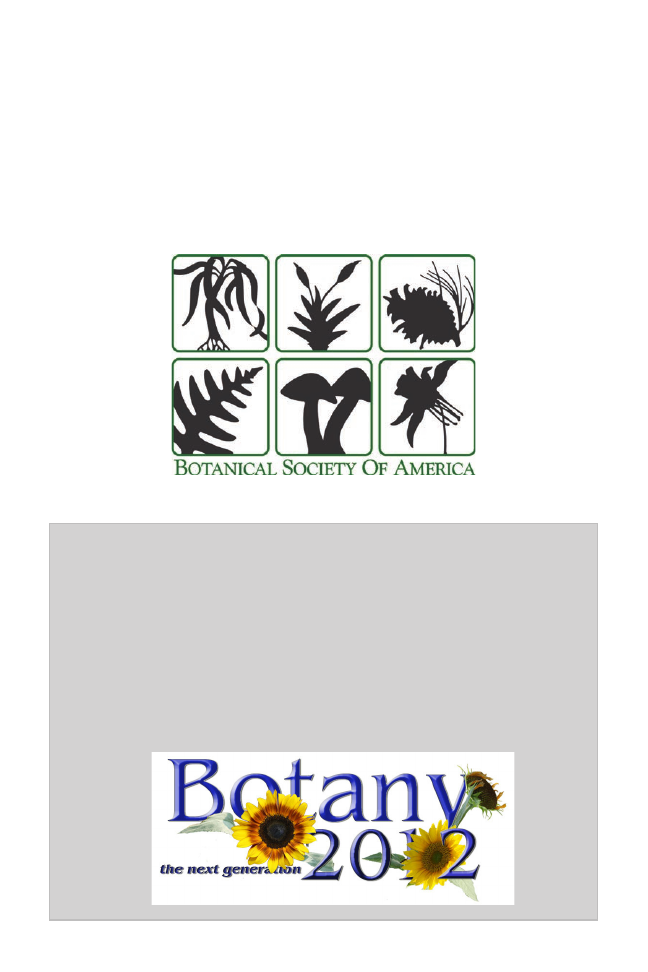
34
Plant Science Bulletin 58(1) 2012
mistakes, and format inconsistencies of little importance for the reader. However, Compositae is misspelled
throughout, and in a couple of instances “cm” should be “mm.”
The appendix of field station flora (species list, locator map, and nine pages of photos) is a special delight:
it adds another 19 “bonus” plants (images only) to the species fully treated in the book. The price for this
attractive and well-done volume makes it a worthwhile addition to one’s library. I wish Kass’s book had
been available when I made my trip to the Bahamas!
–Donna Ford-Werntz, Herbarium Curator, Biology Department, West Virginia University, Morgantown,
West Virginia, USA
The AJB staff is excited to announce the speaker for the inaugural AJB Special Lecture at Botany
2012. Gar Rothwell (Ohio University) will present “Integrating Plant Evolution, Paleontology, and
Molecular Genetics: A Developing Paradigm.”
Rothwell’s talk will focus on how, within the developmental framework, evolution can be
interpreted as proceeding by the successive alteration of ontogeny, which is mediated via
regulatory genetics. Neither genetic sequences nor experimental manipulations of development
are directly available to the paleontologist. Nevertheless, by identifying structural “fingerprints” of
developmental regulatory mechanisms, ontogenetic patterns can be inferred from the morphology
and anatomy of extinct plant species.
For more information on this talk, go to www.botanyconference.org.
American Journal of Botany Special Lecture at Botany 2012

35
BOOKS RECEIVED
Evolution of Plant-Pollinator Relationships. Sébastien Patiny. 2012. ISBN-13: 978-0-52119-892-9 (Cloth
US$119.00) 477 pp. Cambridge University Press, New York, New York, USA.
The Golden Age of Flowers: Botanical Illustration in the Age of Discovery 1600–1800. Celia Fisher.
ISBN-13: 978-0-7123-5820-0 (Cloth US$29.95) 144 pp. The British Library. Distributed by the University
of Chicago Press, Chicago, Illinois, USA. (in review)
Hardy Heathers from the Northern Hemisphere: Calluna, Daboecia, Erica. E. Charles Nelson. 2012.
ISBN-13: 978-1-84246-170-9 (Cloth US$100.00) 442 pp. Royal Botanic Gardens, Kew. Distributed by the
University of Chicago Press, Chicago, Illinois, USA.
The Jepson Manual: Vascular Plants of California, 2nd ed., Thoroughly Revised and Expanded. Bruce
G. Baldwin, Douglas H. Goldman, David J. Keil, Robert Patterson, Thomas J. Rosatti, and Dieter H. Wilken
(eds.). 2012. ISBN-13: 978-0-520-25312-4 (Cloth US$125.00) 1568 pp. University of California Press,
Berkeley, California, USA.
Joseph Hooker: Botanical Trailblazer. Pat Griggs. 2012. ISBN-13: 978-1-84246-469-4 (Paperback,
US$17.00) 64 pp. Royal Botanic Gardens, Kew. Distributed by the University of Chicago Press, Chicago,
Illinois, USA.
Obadiah Gray and the Search for the Elusive Eponym. Thomas G. Lammers. 2011. 66 pp. Published by
the author, Oshkosh, Wisconsin, USA.
Peonies of the World: Polymorphism and Diversity. De-Yuan Hong. 2012. ISBN-13: 978-1-84246-458-8
(Cloth US$115.00) 94 pp. Royal Botanic Gardens, Kew. Distributed by the University of Chicago Press,
Chicago, Illinois, USA.
Sources, Sinks and Sustainability. Jianguo Liu, Vanessa Hull, Anita T. Morzillo, and John A. Wiens. 2011.
ISBN-13: 978-0-521-19947-6 (Cloth US$130.00) 525 pp. Cambridge University Press, New York, New
York, USA.
Tropical Plant Collecting: From the Field to the Internet. Scott A. Mori, Amy Berkov, Carol A. Gracie,
and Edmund F. Hecklau. 2011. ISBN-13: 978-85-6500-500-5 (Paperback US$34.95) 332 pp. TECC Editora
LTDA, Florianópolis, Santa Catarina, Brazil.
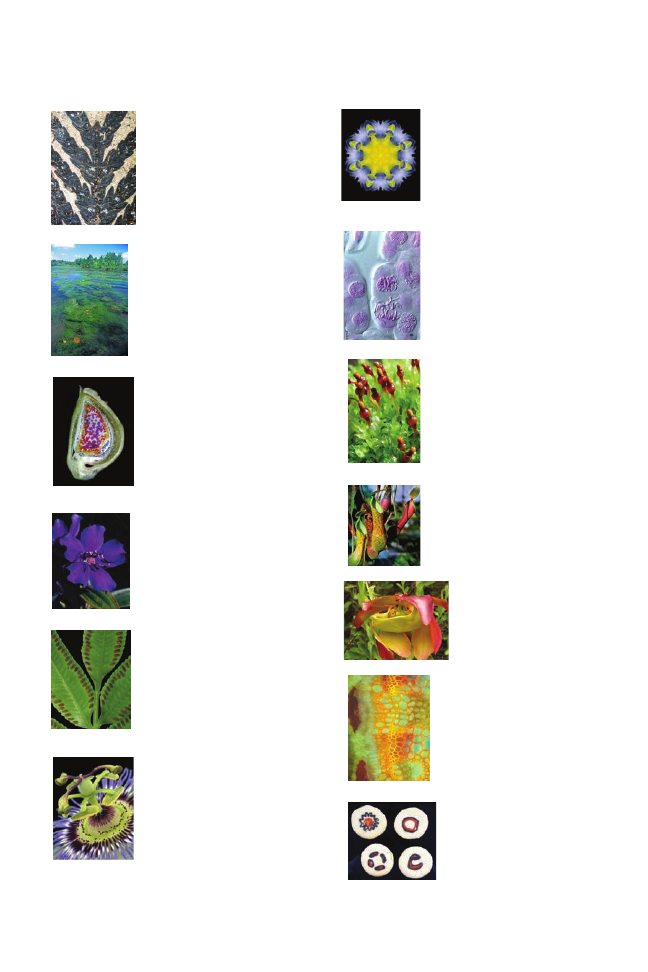
36
Plant Science Bulletin 58(1) 2012
Plant Ed Images
Submitted Images through the years
Foliage of Papuacedrus
prechilensis (Berry) comb.
nov. (Cupressaceae), from the
middle Eocene Río Pichileufú
flora of Río Negro Province,
Patagonia, Argentina. Credit:
P. Wilf
Darwin proposed in 1859
that most aquatic plants were
dispersed by birds. One of
these bird-dispersed aquatics
is wigeon grass (Ruppia L.,
Ruppiaceae) Credit: Norio
Tanaka
Longitudinal section of the
developing caryopsis of maize
ancestor, teosinte (Zea mays
ssp. parviglumis, caryopsis
diameter ca. 3 mm. Credit: Aleš
Kladnik
A flower of Tibouchina semi-
decandra, a well-known orna-
mental from southeastern Brazil.
Credit: Suzanne Renner
Marattia howeana (W.R.B.Oliv.)
P. S. Green, a rare endemic
to Lord Howe Island with
only a few known remaining
populations. Credit: Andrew
Murdock
Photograph of Passiflora
caerulea L. flower showing the
enigmatic corona, a complex
series of structures that lie
between the petals and the
stamens.
Credit: Simon Malcomber
Tension tissue in transverse
hand section of internode 7.
Credit: A.M. Patterson
Cookieales, a very special
image. Credit: Judy Jernstedt
Anaphase A.
Credit: Scott Russell
Nepenthes, sp., leaves
Credit: Marshall Sundberg
Northern pitcher plant,
Sarracenia purpurea,
showing ants collecting
nectar in the flower.
Credit: Joy Marburger
Splachnum ampullaceum
Credit: Frank Boas
Cuscuta (dodders) species are
obligate parasitic plants with
stems that resemble yellow-orange
spaghetti. Credit: Mihai Costea
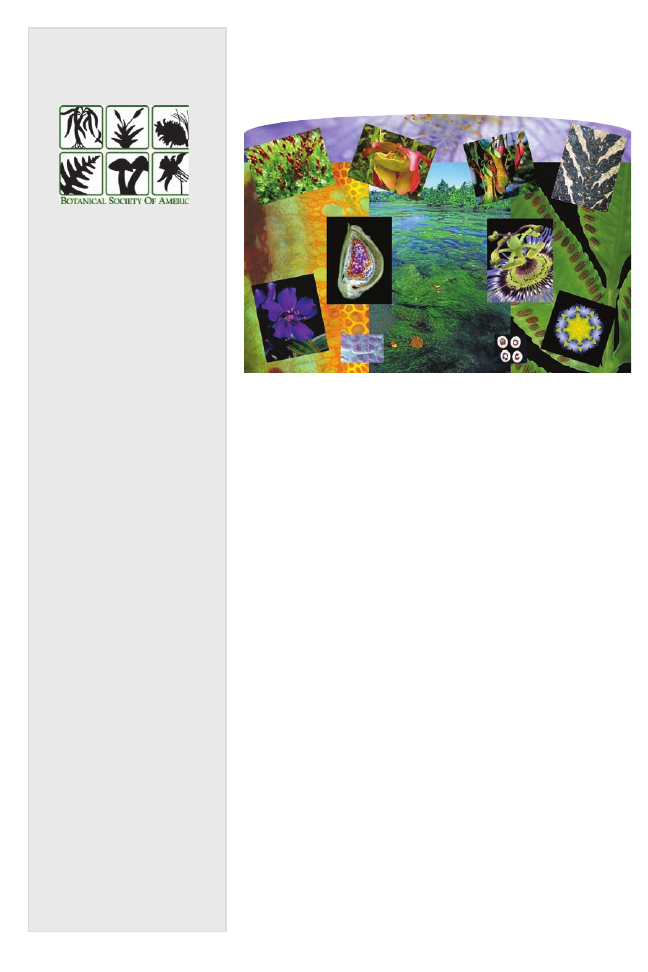
Plant Science Bulletin
Featured Image
Spring 2012 Volume 58 Number 1
Plant Science
Bulletin
ISSN 0032-0919
Published quarterly by
Botanical Society of America, Inc.
4475 Castleman Avenue
St. Louis, MO 63166-0299
Periodicals postage is paid at St.
Louis, MO and additional mailing
offices.
POSTMASTER:
Send address changes to:
Botanical Society of America
Business Office
P.O. Box 299
St. Louis, MO 63166-0299
bsa-manager@botany.org
The yearly subscription rate of $15 is
included in the membership
Address Editorial Matters (only) to:
Marshall D. Sundberg
Editor
Department of Biological Sciences
Emporia State University
1200 Commercial St.
Emporia, KS 66801-5057
Phone 620-341-5605
psb@botany.org
The Botanical Society of
America is a membership
society whose mission is to:
promote botany, the field of
basic science dealing with the
study and inquiry into the form,
function, development, diversity,
reproduction, evolution, and uses
of plants and their interactions
within the biosphere.|
Changing Times
In the early 80s, BSA members began exchanging Kodachrome/
Ektachrome slides as a means of sharing images for teaching
purposes. This was led by members such as Katherine Esau, Nels
Lersten, Marshall Sundberg, David Webb, Ann Hirsch, John Curtis,
and many more who donated their photos to the cause. In the late
1990s, presented with advancing Internet technologies, these slides
were scanned by Tom Jurik and David Webb in conjunction with
David Kramer’s Education Committee to make this resource more
easily available. At nearly 1 GB in data, the cost of a commercial
site would have been prohibitive so Scott Russell built his first Linux
server, wrote the software, and constructed the site at http://images.
botany.org/. The site went live at the start of the 1999 International
Botanical Congress at St. Louis. Later, as web access and speeds
continued to grow, we added higher-resolution images, including
all of the AJB covers, a stunning set from Judy Jernstedt, and other
images from Nancy Turner, Ron Stuckey, and Pat Gensel. In 2002, we
also moved the collection to the main BSA site at http://www.botany.
org/plantimages/.
In 2003, the BSA joined the AAAS Biological Education Network
(BEN) digital portal as a means of supporting broader dissemination
for our images. We also gained the ability to provide educational
resources of all types to the community.
In 2010, we joined with the Ecological Society of America (ESA), the
Society for Economic Botany (SEB), and the Society for the Study of
Evolution (SSE) to develop a user-friendly portal designed to add a
peer-review module to assess incoming resources. It also allows the
Societies to share resources in an effective and efficient manner. Our
interface with the site will be called PlantED.
Dr. Beverly Brown (Chair) and the BSA Education Committee are
playing a key role in the PlantED development. Please take the time to
attend the PlantED workshop run by Beverly on Sunday, July 8, at the
Botany 2012 Conference in Columbus, Ohio.
Right now, we’d like your help in adding the next generation of images
and plant-related teaching materials to the PlantED site. Go to www.
PlantED.Botany.org to find out more about this project and how you
can support our educational outreach efforts.
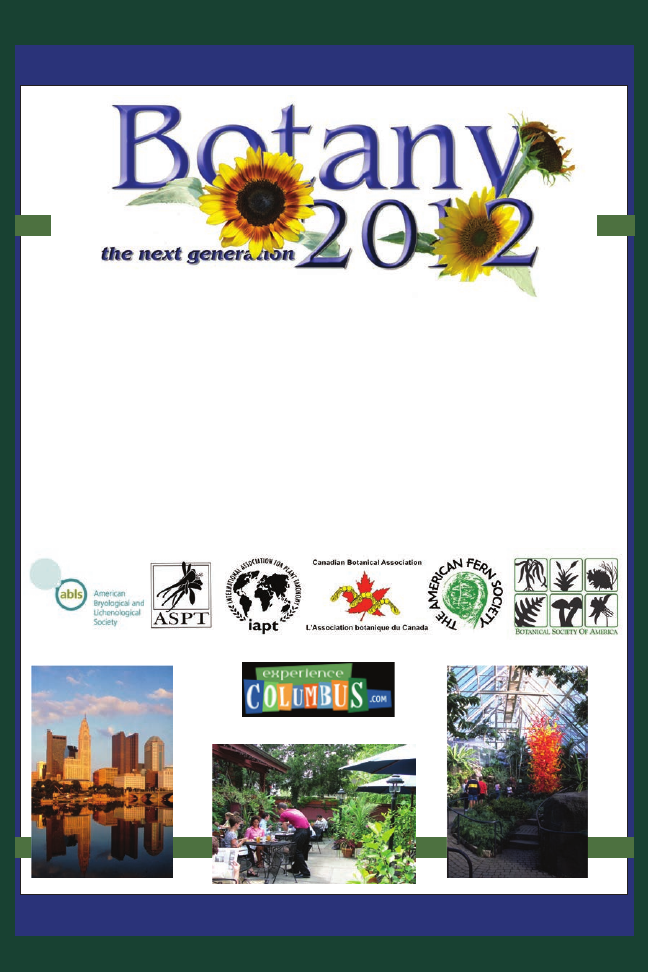
Let’s
Together!
July 7 -11, 2012
Greater Columbus Convention Center
Columbus, Ohio
Abstract Submission Deadline April 1
Register Early for great rates and housing choices
www.botanyconference.org
The Annual Meeting of
these premier scientific societies